#I would corroborate their story with great enthusiasm
Explore tagged Tumblr posts
Text
is it bad that when I tell someone a story about something that happened to me and I share a context with that person (work for example) and then they vaguely mumble back to me that they ran into the person from the story/heard the exact thing I was talking about/had the same discussion I’m referencing I just absolutely do not believe them? like. I’m like “x happened to me today” and they’re like “oh yeah I heard about that from y” my internal voice just automatically goes “liar”
#but maybe it’s just a difference in delivery that I’m judging#because if someone told me story and I had external proof of it (that wasn’t painful for them to know/from an inappropriate source#I would corroborate their story with great enthusiasm#a sort of putting the puzzle pieces together in the dead of night thing#and they just say it nonchalantly#but I hear the nonchalance and am just like ‘why are you lying’#or not even nonchalance —but the indecision#if you are telling the truth why are you speaking indecisively??? why are you trailing off???????????#it makes me SO suspicious#but yeah. maye it’s just a matter of tone#on the other hand I am starting to suspect that way more people are regularly lying to me than would admit it#which is very gross#don’t they know the truth will set them free etc.
6 notes
·
View notes
Text
Betrayal

Today is Holy Wednesday, also known in the historic Church as Spy Wednesday, Good Wednesday, or Great Wednesday.
For centuries this has been the day that Christians commemorate Judas' conspiring with the Sanhedrin to betray Jesus and turn him over to them to be arrested.
In John's Gospel, it seems that Judas' betrayal is connected to his being a dishonest, shifty person, who kept the money for the group but skimmed off of it for his own gain.
This claim is not corroborated in any of the other Gospel accounts. In fact, in Luke's Gospel, the narrator declares that "Satan entered Judas," who agreed with the Sanhedrin to betray Jesus for money.
Interestingly, the first-century Christian text The Gospel of Judas paints him as a hero of sorts--the only disciple who was willing to take on the impossible task of initiating the Passion of Jesus by what appeared to be a betrayal.
The first-century Christians who adhered to The Gospel of Judas believed that when Jesus said to Judas "Do you have to do." at The Last Supper, he was giving him his marching orders.
As fascinating as it is to read, The Gospel of Judas did not reflect the majority view of the events of Holy Week, nor did it reflect the view of Judas held by most first-century Christians.
But maybe it was picking up on something interesting and meaningful. Let me explain...
Like most of us, Judas was neither all bad nor all good. His open betrayal of Jesus may have been based on his own frustrations with Jesus regarding revolution, and an armed rebellion.
He could have been trying to force Jesus' hand, as well, which some scholars over the years have surmised. Or it's entirely possible that he was simply jealous and angry over his less-than role in the group, as opposed to Peter, James, and John.
Whatever his motivation, Judas did what he did, and later repented of it in dramatic fashion, throwing the money he was given back at the very leaders who recruited him, and then committing suicide--according to some of the Gospel accounts.
Think about this, though. Along with the other disciples, Judas participated fully in the life they led following Jesus. The disciples performed miracles, according to the text. They preached, taught, and witnessed all that Jesus did.
Judas would have done all these things. At one point he was filled with promise, enthusiasm, and probably hope as well. But something changed within him, and he did the unthinkable.
I often think about the story of Judas when I begin to ponder my own life of faith.
Sometimes what starts with the best of intentions can turn into betrayal when I feel as though my life of following Jesus isn't paying off as I think it should.
It's all too easy to betray our values, character, and even all the things we say we believe when it feels like our world isn't as it should be. We want to force God's hand, or simply wrest control away from God to get what we want.
This is why we see far too many Christians conflating politics with religion, blurring the lines between the kingdom of God and the kingdoms of this world, putting their faith and trust in anything but Jesus.
Judas' story is a cautionary tale for us, and on this Holy Wednesday, we get the chance to reflect on all the ways we have handed Jesus over to be crucified and to repent of them.
We get the chance to return to our former promise, enthusiasm, and hope.
May it be so and may the grace and peace of our Lord Jesus Christ be with you now and always. Amen.
#presbymusings#dailydevotion#leonbloder#dailydevo#christian living#dailydevotional#faith#leon bloder#spiritualgrowth#spirituality#judas iscariot#Holy Week#Holy Wednesday
1 note
·
View note
Text
Almost done with firefight...
So I’ve almost finished firefight by Brandon Sanderson, the second book in the Reckoners series. I feel pretty lukewarm about this book– despite trying to break this book into parts, I still didn’t feel super compelled to read this one. Granted my life has been a bit hectic and I haven’t had a lot of time to spend on reading but I genuinely feel like if this had been as action packed as Steelheart was, I wouldn’t be bothered by this. Steelheart was the sort of book you didn’t want to put down, whereas this one I almost couldn’t be bothered to pick it up.
I will say, that in the last third when Megan rejoins the plot, the book starts to pick up. Megan and David have a really great dynamic that feels pretty atypical of YA. David’s a perfectly written dork, and while Sanderson gives him his cool moments, it never feels like he’s trying too hard because you have so many moments where you just have to laugh at him (my favorite being his insistence that he is not a nerd) Megan balances him really well, she grounds him but at the same time she needs his sort of infectious enthusiasm in her more jaded world. I like their relationship and it’s pretty refreshing at the end of the day compared to a lot of other romances I’ve seen.
We’re kind of entering the endgame here, so spoilers ahead (I’ve only gotten to part 4 so far) * SPOILERS AHEAD *
Even though I’ve missed Cody and Abraham a lot this book, I’m glad that they’re not apart of this plot to undermine David. The whole thing feels messed up on a lot of levels.
Part of me wants to say it’s the powers that are warping the Prof (Honestly, at this point I wouldn’t be surprised if he ends up being the big bad of book 3) but I feel like it’s something else. David’s belief that Epics can change and be good is something that Prof obviously used to really believe in, and he views it as a dangerous route to go down, so he travels as far from it as he can. David’s insistence on studying the weaknesses and that Megan is innocent strike to close to that, and I feel like this is where a lot of the issue comes from.
Then there is Megan, who Prof distrust’s a lot, even though as David points out, Prof still doesn’t have the whole story. Megan’s not someone who has a history of violence like other epics, though Prof definitely strikes me as the sort of person that once you break the trust, it’s pretty hard to regain. And yet it feels too much like he wants a reason to distrust her, and isn’t really giving her a fair shake. Arguably David is doing the same thing, he is too trusting, but Megan’s actions are questionable enough for me to at least consider what she is saying (Read: I think that while Megan is still questionable, Prof & co too easily write her off) On the subject of Sam, I find it strange that David hasn’t really asked her about it– and she hasn’t really denied that she did it. It’s definitely strange, but I feel like there is probably more to it than we know.
While I feel like the sort of endgame-setup-plot twist for this book is good, it’s also strangely frustrating. It took over 300 pages for the book to really get interesting (first fight scene notwithstanding) and around 25 pages after that for the David-is-a-traitor plot to kick in. They are both good concepts, but I don’t know if they are set up or executed the best. In fact, while David and Prof have a pretty good scene, every other character gets the short end of the staff here and distrust David way too quickly. Not that it isn’t believable, since they don’t know him too well– but it still feels shallow.
Like Val (who should be smart) thinks that Regalia somehow set up David, who has very clearly never left Newcago in his life, and literally had a corroborating story about steelheart from his childhood, to infiltrate the reckoners. It’s a huge leap in logic, and maybe she doesn’t know everything about David or she’s too emotional, but it still feels pretty jarring. Exel and Missy also are mad at him but it doesn’t really feel that bad because honestly i’m not that invested in either of them and Sanderson doesn’t spend time on actually delineating how they feel. At least at this point, it feels like a good concept that is rather poorly executed.
And then the prof (and Tia I guess) have the gall to be disappointed in David, even though their whole plan was pretty much setting David up for failure. Maybe this was a test, but it honestly seemed like David failing was something that they expected to happen. After everything they went through in the first book and in the year since then, it just makes me kind of angry. Like, if I were David, I would be pretty angry about everything. While David was not very subtle about still seeing Megan, he’s a teenager and Megan was a former member of their group, I don’t know– I understand why they are mad at him, but at the same time everything he did with Megan was in an attempt to undermine Regalia. Like it’s not as if he was helping supply Regalia weapons (If that was what happened it would have made these events more believable) They intentionally keep David in the dark about what actually happened with Sam, try to give him a chance to confess while making it pretty clear that no matter what Megan is still taboo, and David acts like a confused teenager keeping a secret because he’s dumb and doesn’t always make the right call? It’s not like they are unjustified, but they still used David and it makes their ostracisation of him just come off very poorly.
I suppose the last thing I want to talk about is Regalia and the actual Endgame here. I think the biggest thing for me right now, is despite everything, Regalia is still a huge enigma, and even though Tia and Prof knew her personally I feel like none of them are even close to cracking the puzzle that is her. Watch me be wrong, but I feel like David’s right and that all of the puzzle pieces haven’t really come together, which is why the fact that they are gearing up for the final phase against Regalia feels so… out of place. Compared to the previous book where they had already had a few significant hits on Steelheart, they have almost nothing on Regalia aside from a few of David’s efforts. The certainty that the reckoners operate with that they understand the situation feels a bit out of place, especially compared to Steelheart where the plan was very clearly delineated, and they had already gained a lot of information, while Babilar still feels off in a lot of ways. Everything they have learned at this point feels like it has brought more questions and very few answers.
Also, kind of random, but using the assumption that Regalia thinks David is compromised could kind of work. They could use that as part of a trap I think, but they trust him so little that they don’t even consider that– which I think is where a lot of my issue’s come from– despite being in the Reckoner’s for over a year, the fact that they disregard all of that over a genuinely trippy situation, I don’t know it just makes me mad at a lot of the characters. Like I get that Val is emotional because Sam died, but does it really seem that plausible that Regalia planted an unknown guy who didn’t even know how to swim, with a corroborating story of Steelheart into the reckoners? I mean, who knows if she knows the whole story, but it’s still a ridiculous accusation. I could go on, but I’m mad that the characters distrust David so easily, like if anything it almost feels forced. We also don’t really get anything from say Tia, maybe we will later but while i love the concept of David being thrown under the bus, I feel like the buildup to it could have been better, and if the execution of it could really have been improved. Anyways, I’m probably going to read part 4 tomorrow and we will see if any of my issues dissipate- I’ve heard this book has a good ending so we’ll see. If I’m going to make any predictions, right now I will say–
1. Sam was messing around with something he shouldn’t have and that’s why Megan went after him 2. Regalia is doing this elaborate plot to not only draw Prof out but to force him to use his powers and to succumb to their influence
À bientôt!
2 notes
·
View notes
Text
The Not-So-Amazing Mary Jane Part 16: MJ is being extremely selfish

Previous Part
Next Part
Master Post
Last time I pointed out how its a false equivalency to claim being Spider-Man’s lover is no more dangerous than working with Mysterio.
This time out I will detail how MJ is, at least arguably, being extremely selfish in AMJ #1. Specifically, selfish in regards to her career. To explain how and why though we’re going to have to delve into MJ’s life priorities, in particular how she views her marriage to Peter.
There are various scenes in AMJ #1 that at least imply she is:
Leveraging her silence to improve her character’s role in Mysterio’s movie
Impressed/excited to be working on the movie
Hoping the film will serve her future career prospects well; possibly by opening up the possibility of a spin-off for her character.
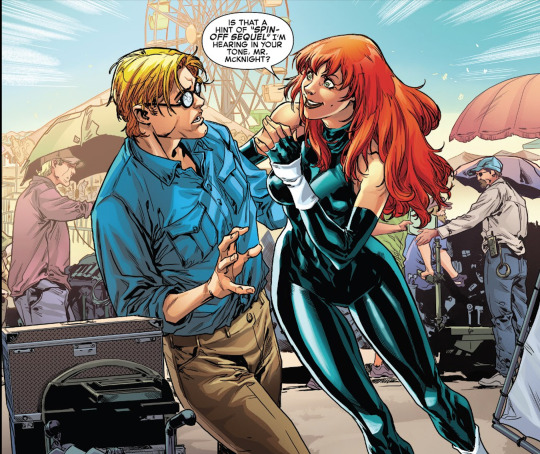
When taken in context of the story it can come across as though MJ’s sincere enthusiasm for making the films, and her hopes It will aid her career, are factors in her keeping quiet about Mysterio.
That in addition to any hypothetical sympathy she might possess for Beck/his crew, any hopes they could use his opportunity to reform (or at least contribute something positive to the world), she is also thinking about herself.*
On the other hand that might not be the intent by Williams, Gomez. Or it might not be how the story pans out.
But for the sake of argument let’s pretend it is. In that case then it would be yet another (perhaps the worst) example of mischaracterization in the entire story.
Let me spell it out for you plainly.
Mary Jane would NEVER prioritise her career prospects over the potential safety and well being of innocent people.
Never.
I’d have thought that was obvious but apparently it’s yet another thing that needs to be proven with evidence. Thankfully I have just such evidence.
The first and most obvious reason for why this is utterly out of character for MJ links back to something I mentioned earlier. Specifically in part 9.
We know MJ understands and puts into practice Peter’s underlying life lesson, that she herself tries to live by it in her own way. Peter, pretty much from the day his uncle died, has strived to be selfless in general, in particular in regards to his hero duties. Indeed it is this selflessness that so often strained his romantic relationships, which included his one with MJ.
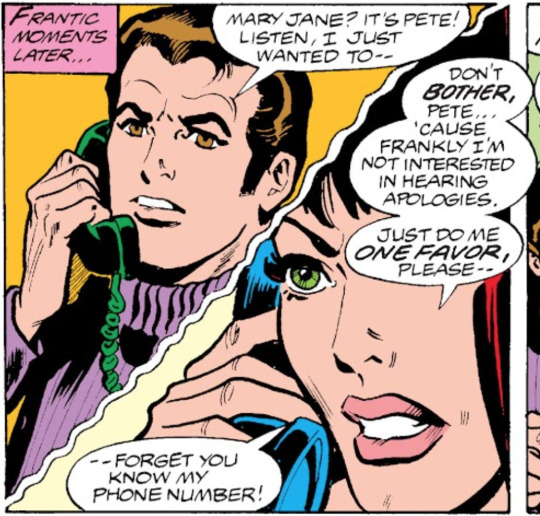
It is therefore not believable that for her own financial or career interests MJ would be so lenient with criminals or allow them to operate essentially freely with no accountability. At best this is still fairly similar to what Peter did in Amazing Fantasy #15.
One might argue that MJ just values her career thatmuch. That she has had such struggle so hard to make it work in the past that this opportunity is something she doesn’t want to let slip by.
This then calls into question just how much MJ values her career in the grand scheme of things, so let’s take yet another dive into history lesson to examine that.
In ASM #303 Peter was offered a great new job, the catch being that it was in Kansas. This would not only entail moving to that state but also MJ potentially giving up her beloved modelling career. MJ was forced to question what was more important to her, her career or her marriage.
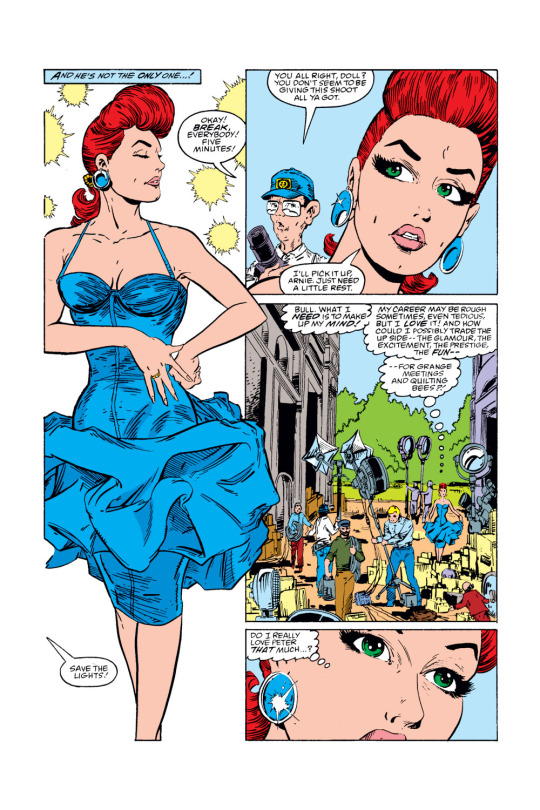
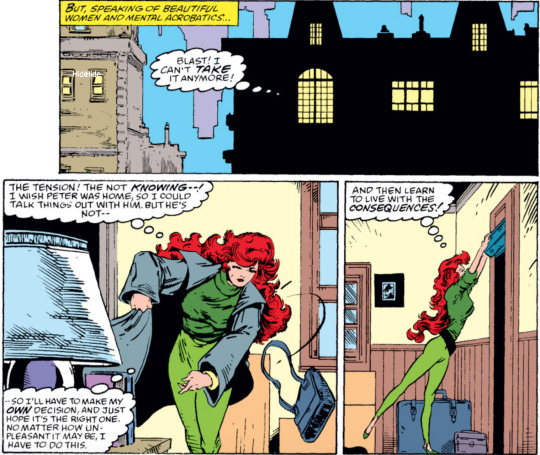
Ultimately she decided it was her marriage, though thankfully Peter opted to turn the job down for her sake.
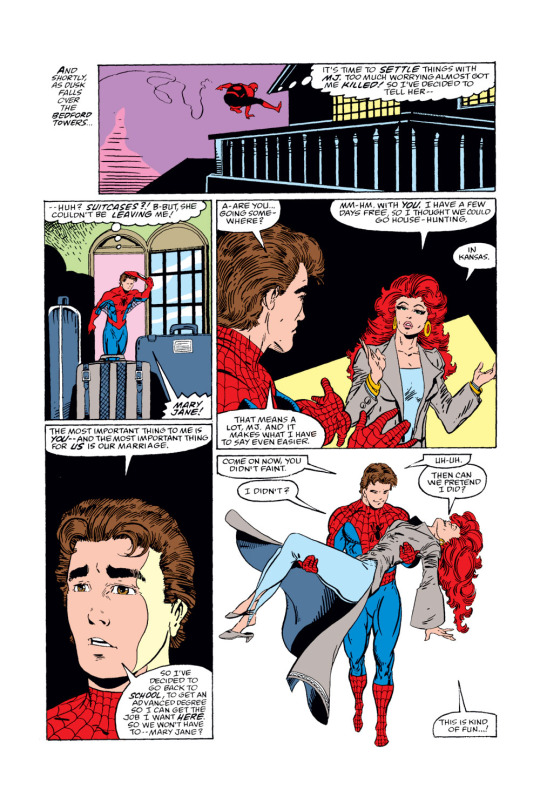
Another example can be found in ASM #502, which transpires not too long after Peter and MJ have gotten back together following a separation. Immediately following their reconciliation MJ took a break from her fledging acting career, having just starred in a super hero movie, Lobster Man. She did this in order to move back to NYC and work things out with Peter. In this issue though she raises the topic of returning to work (which would involve spending a lot of time in L.A.) but qualifies she won’t if it would risk harming their relationship.

More recent stories maintain this characterization, such as ASM v5 #29 which actually leads directly into AMJ. In the issue MJ clearly wants to take up the role in Mysterio’s movie offered to her. But she is also torn because it would entail leaving Peter for a long while. Peter, aware of her feelings, reluctantly encourages her to go. It is heavily implied this encouragement is at least an important factor in MJ’s decision to pursue the role, but even then she raises the idea of changing her mind.

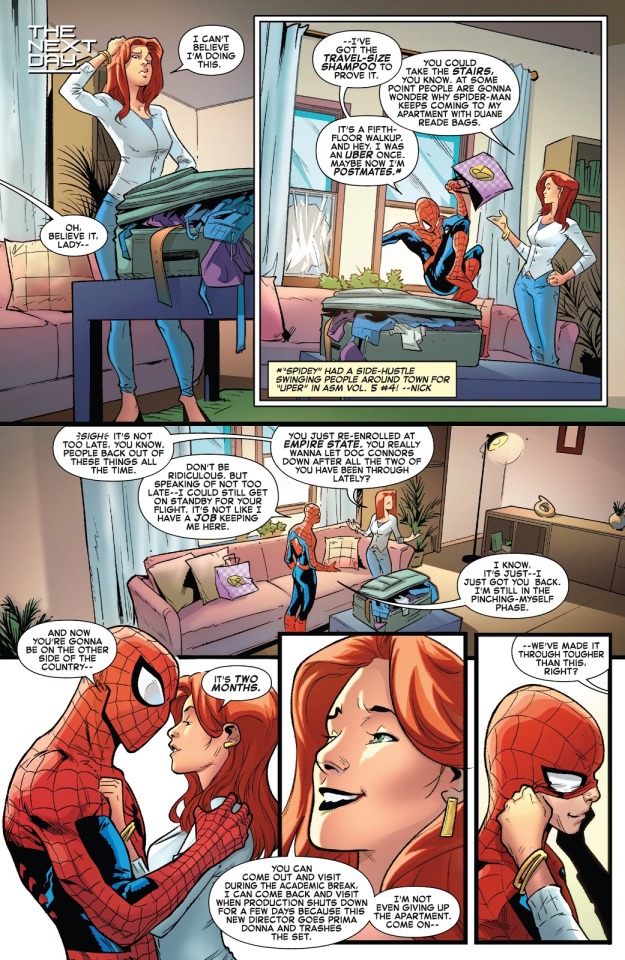
To jump back in time a little, Sensational Spider-Man v2 #32 provides us with our final example of how MJ values her relationship with Peter over her own career.
In the issue MJ is dealing with the ramifications of Peter unmasking to the world and consequently (along with MJ and Aunt May) going on the run when the Super Human Registration Act was enforced.
Pushed to her wits end and wrestling with her life falling apart MJ is frustrated by her loss of status and career. However, by the issue’s end she’s come to terms with her new status and reaffirmed her commitment to her husband.


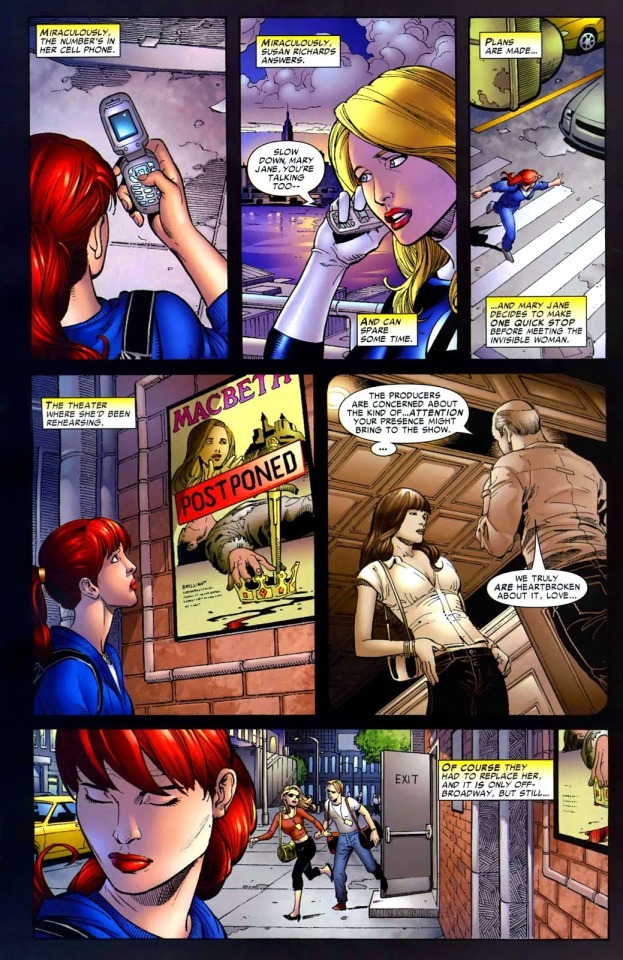

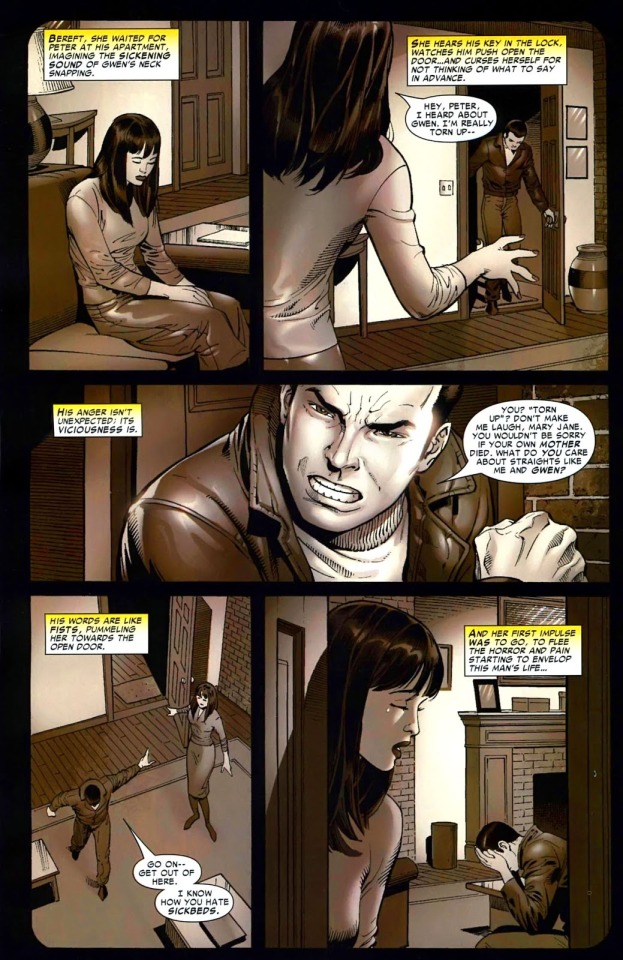
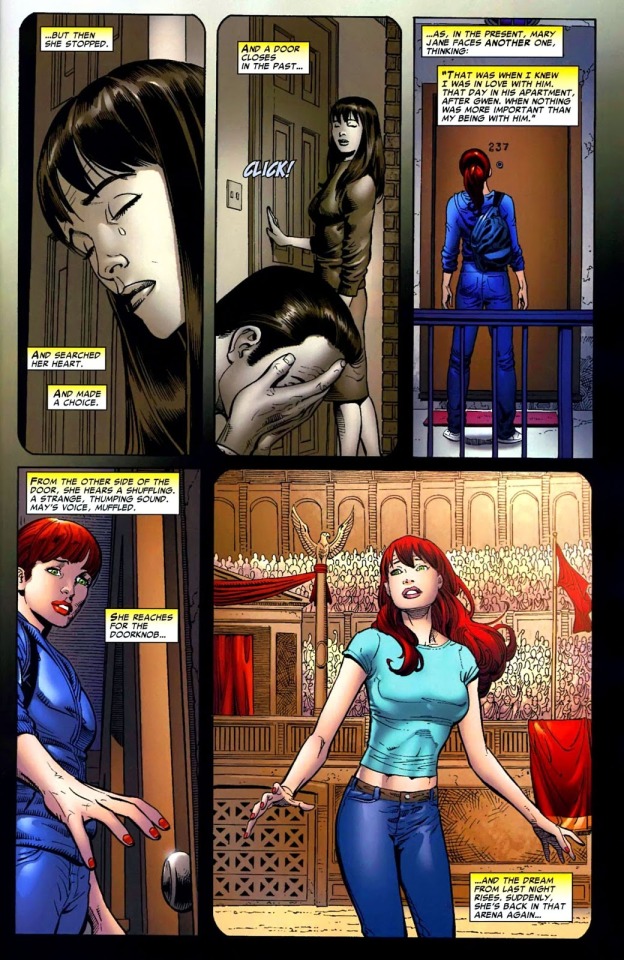
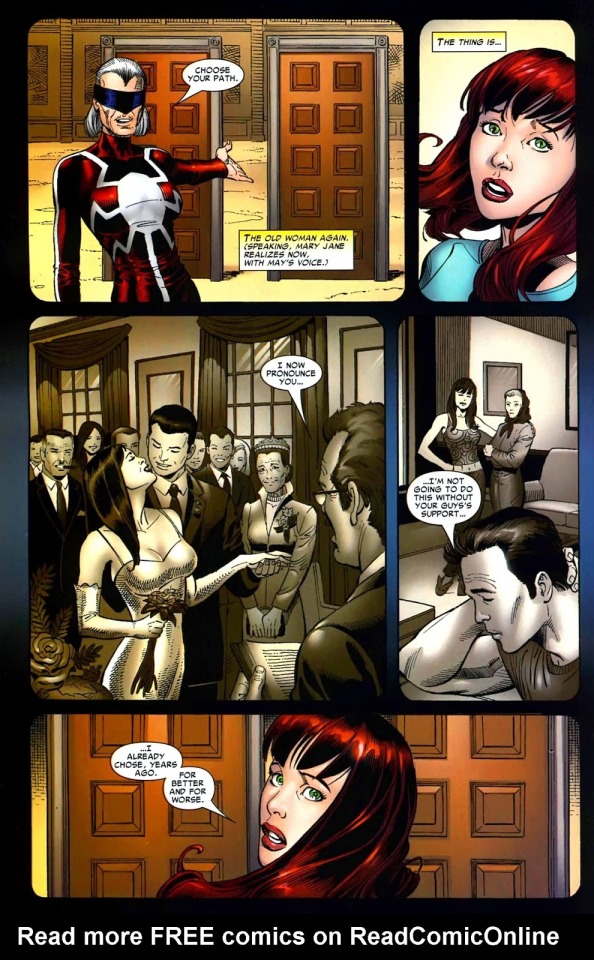
For sure, these are not a 1:1 equivalent to the situation under discussion. In AMJ we’re talking about MJ’s career vs. her sense of justice and in the above examples the question is between her career vs. her marriage.
It’d be fairly easy to argue that obviously MJ values her marriage more than her career, as Peter himself does too. Surely most people in healthy relationships have similar priorities?
But by the same token wouldn’t common sense dictate that if MJ was willing to give up her career for the sake of a relationship she’d also be willing to give it up for something that, in the grand scheme of things, is actually much more important; namely people’s lives?
After all, Peter may well give up his heroic duties for the health of his loved ones, but he wouldn’t do it simply to retain a relationship with them. This is evidenced in ‘Maximum Carnage’ when Peter reluctantly goes against MJ’s wishes of taking a break due to Carnage attacking the city, a fact MJ ultimately accepted.
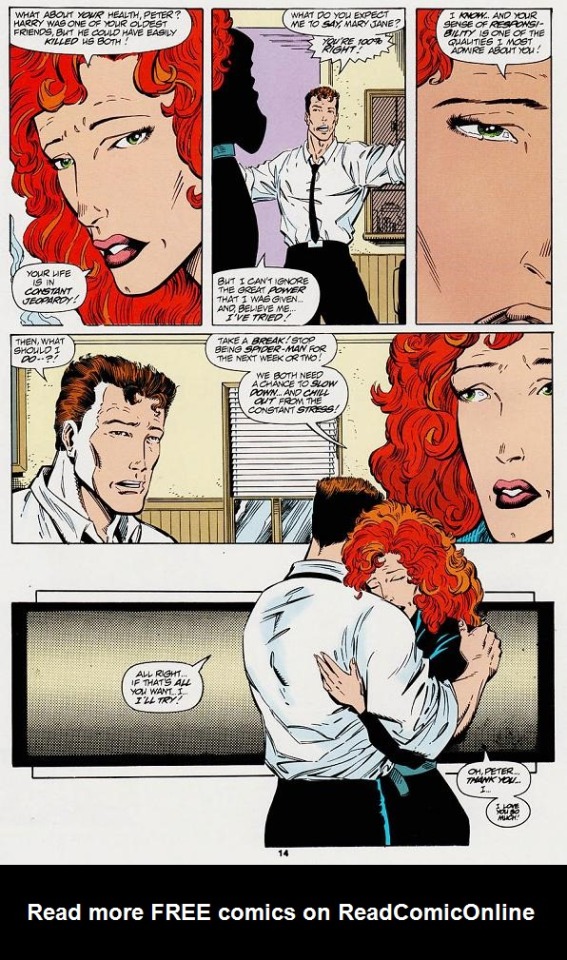

This shows us that, as hard as it can be for Mary Jane, she believes in the need for Spider-Man in the world (to protect the innocent and apprehend crooks) and places the importance for that over her relationship with him.
She might not like it, but she recognizes the greater good.
This sentiment is further corroborated in ASM v2 #50, wherein MJ and Peter try to patch up their marriage. In the conversation MJ outright states that she never wanted nor expected Peter to place her above his duties, and that she never wanted to interfere with them.***

MJ’s recognition that her and Peter’s relationship is ultimately trumped by Peter’s heroic duties is glimpsed again in ASM v5 #29.
MJ hopes Peter will accompany her to the airport before she departs for L.A. but Spidey stuff gets in the way. Whilst she admits him letting her down again upset her she also calmly acknowledges that his work was more important because he is saving the world/innocent lives.

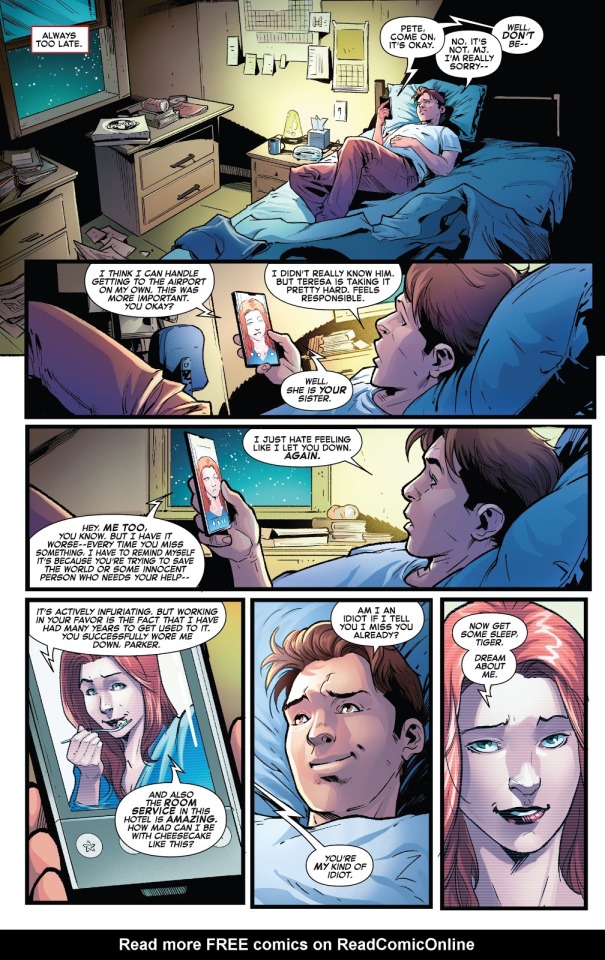
What I’m saying is if MJ ultimately prioritizes Peter’s duties (and thus the well being of innocent people) over keeping her marriage in tact and also values keeping her marriage in tact over her career then obviously she prioritizes innocent lives over her career.
Or to put it more succinctly, MJ’s priorities read like this:
Innocent lives>Her marriage>Her career.
Additionally in Spider-Man Unlimited v3 #2 Mary Jane simply states outright that she values Spidey’s heroic duties as more important than her career.
In the story MJ ponders how it is ridiculous for her to be treated like royalty for being an actress whilst a hero like Spidey gets nothing.
She even denigrates her job in comparison to the importance his role as a hero is. Finally she voices upset about feeling useless in the face of what he does. Her upset is alleviated when Peter informs her that she is an important factor in enabling him to be a hero in the first place.



The story very clearly outlines that MJ places distinctly greater value on Peter’s role as a hero than her job in the entertainment industry.
It also arguably proves MJ on some level wants to contribute to Peter’s role as a protector of innocents and catcher of the guilty herself. In this regard it isn’t alone as some other stories arguably tap into that idea too.
In a part 9 I looked at how in Web Annual #6 MJ keenly participated in jury duty. This could be taken as evidence of MJ wanting to participate in the justice system as Peter (sort of) does. And if we return to ASM v2 #50 we can find a little more food for thought in the very moment Pete and MJ reconcile.
In the trade versions of the issue (which I admit brings the canonicity into question a bit) MJ reveals that the reason she separated from Peter was because she felt like she was unneeded in his life (as Spider-Man), that she wasn’t a part of it and that she couldn’t help.
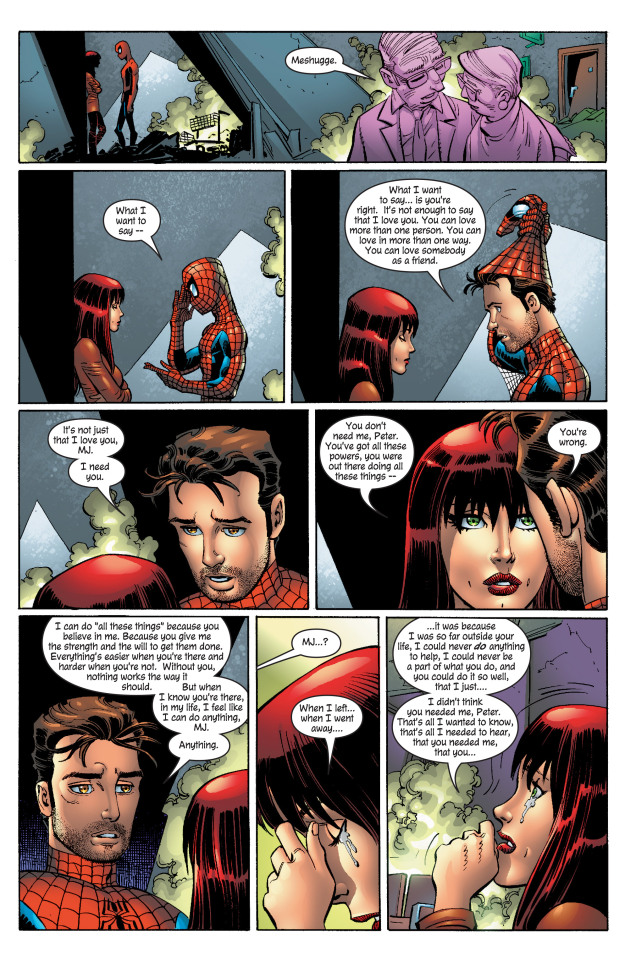
This could be taken as a further example of how MJ in fact wishes to contribute to Peter’s ‘mission’ as it were, though I admit that isn’t a watertight argument.
Furthermore let’s consider a particular moment from AMJ #1 itself. As you might recall, MJ noticed the presence of super powered people and criminals on the film set along with her as well as how the director (Cage McKnight) was avoiding her.
This was in spite of writing the role for her, hiring her without an audition and insisting she be in the movie. MJ was suspicious and confronted McKnight demanding to know what kind of con he was pulling. Although he insisted it wasn’t a set up, his inability to provide any answers led to MJ quitting.
She stated she wasn’t an innocent, naïve, unsophisticated young actress who could be scammed with empty promises and promptly began to walk away.
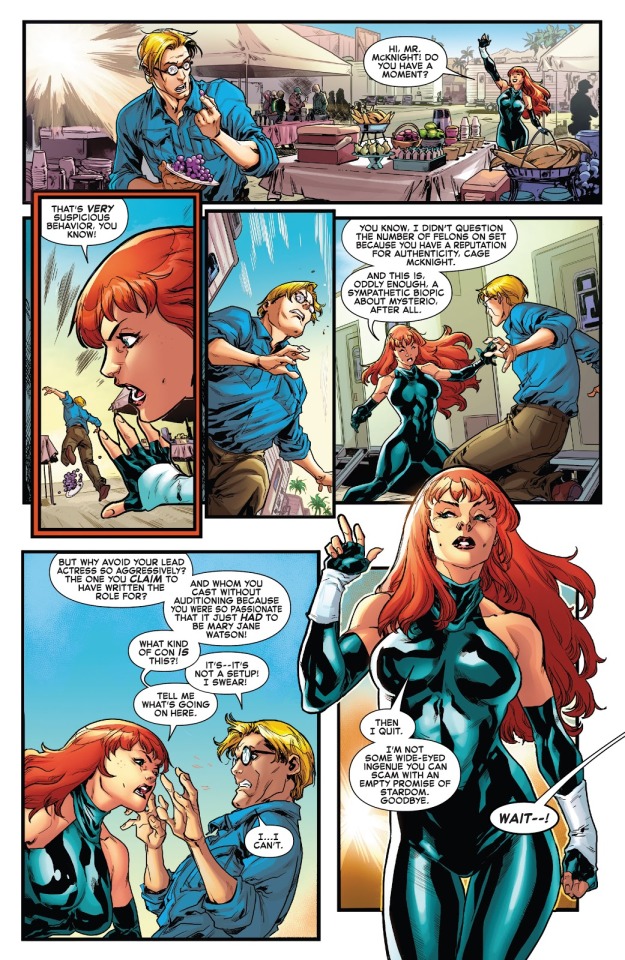
Whilst it’s possible to argue that MJ was simply bluffing in order to know the truth, the likelihood is she seriously intended to leave.
Consider the fact that she has acknowledged the presence of criminals, the director literally running away from her and the questionable circumstances behind her hiring. Specifically she claims to have come to the conclusion that the film is not legitimate.
Do these preceding events really imply that MJ was merely bluffing? Unlikely, she can clearly tell something smells fishy and she’s at the centre of it somehow. Realistically, common sense would dictate not sticking around for the sake of your career, especially if you’ve concluded there isn’t actually a career opportunity to be had in the first place.
Mary Jane doesn’t know the specifics of the con. For all she knows she could be caught up in general crime, some kind technically legal Hollywood scam, a sinister plot connected to Spider-Man (which would technically be correct), yet another obsessed stalker or some kind of #MeToo moment waiting to happen.
Regardless, she was prepared to walk and potentially throw away any career opportunity she might have by sticking around.
If she was prepared to do that with the limited information she had then when she learns of the actual situation why would she stick around?
Now, you could argue that MJ is concerned for the careers and livelihoods of the crewmembers who are not criminals. But even this doesn’t stand up to scrutiny because that’s the equivalent of caring about the people unknowingly employed by a crime lord. If the crime lord goes down they lose their jobs. That sucks, that’s horrible. But their jobs are obviously far less important than the potential lives and livelihoods of other innocent people Beck might harm.
Yes it’s a choice between lesser evils but it’s a necessary choice, and one the police make regularly. People can find new jobs, but lives are irreplaceable after all.
There is some food for thought supporting this too, gleamed from Spider-Man’s own actions.
In a story from Spider-Man Unlimited #11 a poor criminal (named Joe) with a wife and baby is apprehended by Spider-Man. He desperately begs Spidey to let him go for his family’s sake. Though Spidey takes in Joe’s words and is implied to believe him, he ultimately doesn’t agree. Harsh as it might be, he simply tells Joe he should have thought about his family before he broke the law.


At the issue’s end Peter is arguably upset by the experience, and yet he clearly didn’t change how he operated.
Later, in the Clone Saga, Ben Reilly was shocked to learn that his new lover, Jessica Carradine, was in fact the daughter of Uncle Ben’s killer. He learned that as a result of her father being caught by Spider-Man Jessica had a hard life growing up in foster homes. Peter and MJ were fully aware of the situation with Jessica and helped Ben work through his feelings.
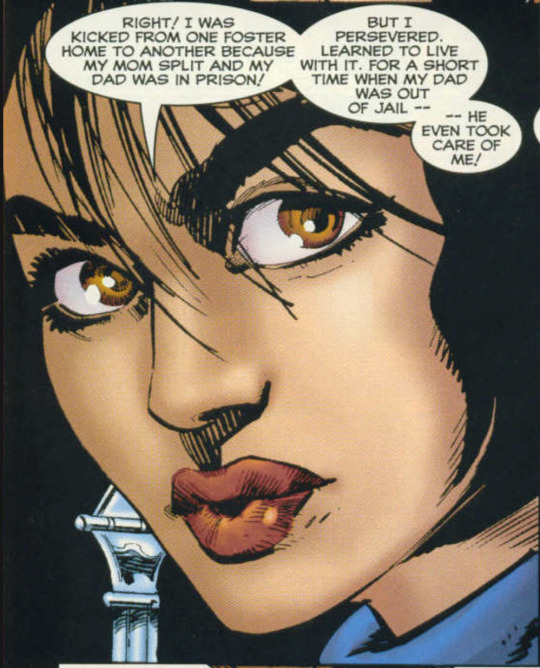
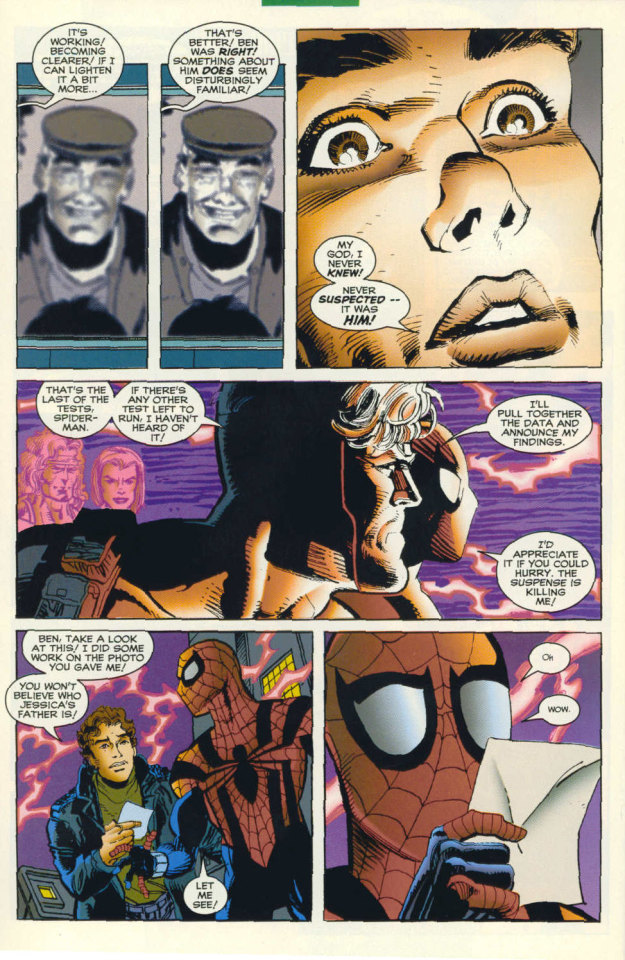


It is important to note that at this time Ben, Peter and MJ all believed Ben was the original Peter Parker, the actual person bitten by the radioactive spider. This meant that as far as they knew Ben was the one who personally apprehended Jessica’s father.
In spite of this information though neither Peter nor Ben ever even considered changing how they operated as Spider-Man, nor did MJ ever suggest they do so in light of Jessica’s experiences
Finally in ASM v2 #55-56 Peter discovers that Melissa (a student he was teaching) was the younger sister of a criminal he apprehended named Joshua. Joshua’s capture had a negative effect upon the rest of his family. This included him keeping his distance after being released from jail. Peter learned that Joshua was hanging out with other reformed criminals under the eye of Ezekiel Sims, a friend of his who knew his identity. Ezekiel basically called Peter out for not checking in on the criminals he captured, nor their families.




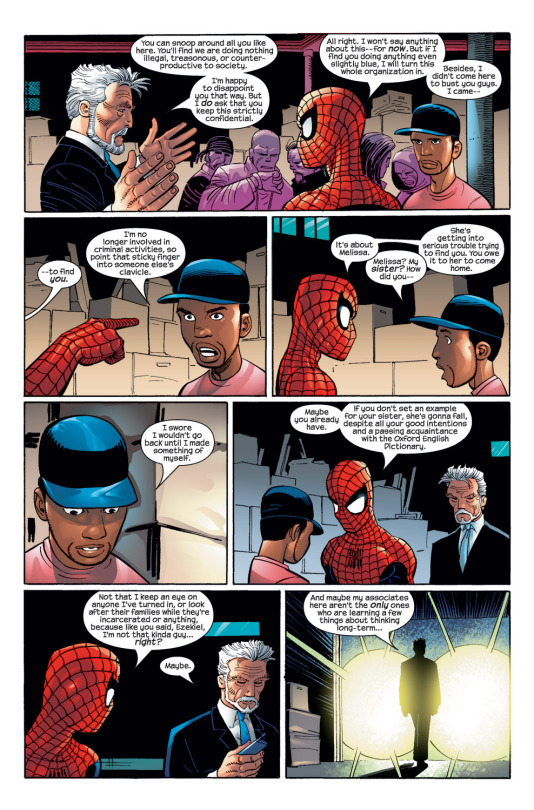
Though Peter claimed this was an impossible task, by the story’s end he did at least consider trying to attempt the feat. He also informed MJ about this incredibly unique experience even in amidst his incredibly unique life, meaning it’s something she’d be likely to remember.
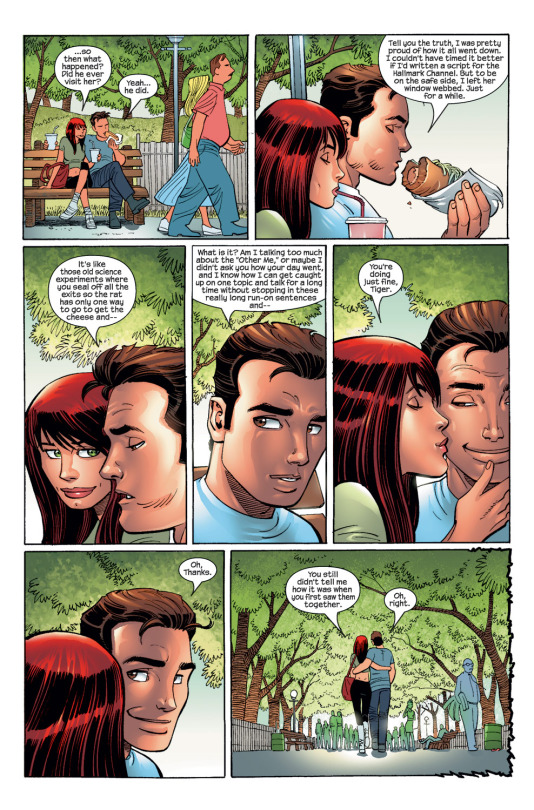
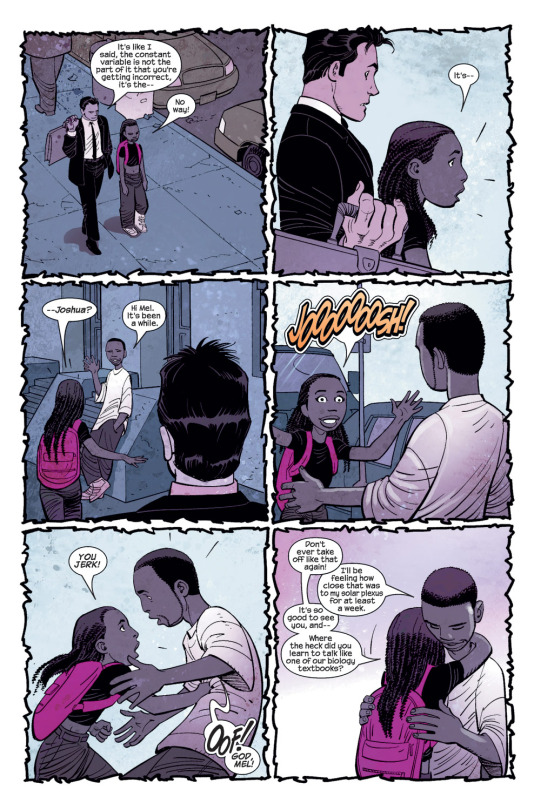
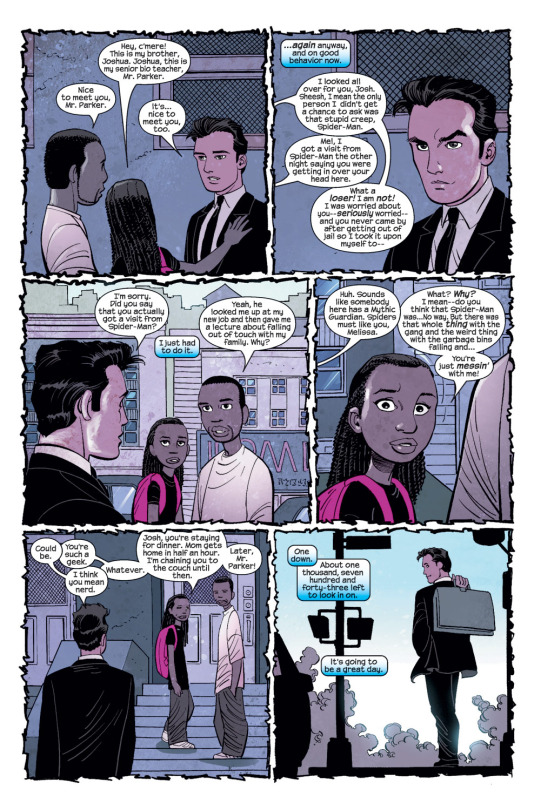
Noticeably though neither in the story nor thereafter, did Peter ever consider not bringing criminals in out of concern for the unintended consequences. In fact, upon learning the truth about Joshua’s group he still made it clear that if they did anything even slightly out of line he’d turn in the organization.
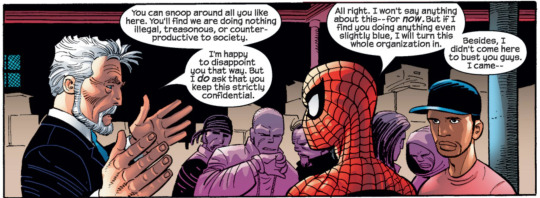
It’s clear from these examples that Peter believes that criminals are worth capturing even if there might be negatives consequences upon their families. It’s something he doesn’t like but his sense of justice places the greater good upon the innocent people who are or might be harmed by the criminals above the families more indirectly affected by the criminals going to prison. Logically the extension of this mentality is that Spider-Man prioritises preventing crime and apprehending criminals over the jobs that might be affected by their capture, because a family seeing one of their own sent to jail and struggling with their loss is obviously not as bad as simply losing your own job.
Once again I will remind you that MJ’s own sense of justice is extremely similar to Peter’s and in fact directly influenced by it. Thus it is very possible that MJ shares this sense of priorities.
But I will admit how much MJ is aware of these incidents and how much she directly applies them to herself can be debated. Nevertheless it’s at least something to consider. Even if you feel these examples are not really applicable to MJ, just real life common sense would dictate that you shouldn’t let dangerous criminals walk free just because you are costing (merely potentially) innocent people their current jobs. Even if they were blacklisted from Hollywood MJ could at least put in a word for them with her acquaintance, billionaire Tony Stark, who might be able to find them other work.
Moving on, next time we’re going to examine the fact that in AMJ Mary Jane is knowingly deceiving Peter.
*Note that they are contributing something important to the world through deceiving investors and using the identity and reputation of someone who hasn’t consented to any of that.
**It is worth bearing in mind that between Ben Reilly being Spider-Man at this time and MJ being heavily pregnant, her desire for him to remain retired was entirely sympathetic.
***Before anyone brings it up, yes, strictly speaking this is not true. Maximum Carnage alone seemingly contradicts this sentiment. But it’s fairly easy to argue that MJ’s dialogue here is speaking specifically about their marriage (not their pre-martial relationship) and excluding extenuating circumstances. Circumstances such as the immediate aftermath of Harry’s ‘death’, MJ’s pregnancy, and Peter being seriously injured. Alternatively it’s entirely possible to argue that MJ is speaking about how she feels deep down at the end of the day, not how she might’ve felt during off days where she was occasionally less understanding than others.
After all Peter himself deep down is dedicated to being Spider-Man but he has quit or contemplated quitting multiple times.
Previous Part
Next Part
Master Post
#Leah Williams#mjwatsonedit#mary jane watson#Mary Jane Watson Parker#MJ Watson#Amazing Mary Jane#Mysterio#Spider-Man#Peter Parker#quentin beck
18 notes
·
View notes
Text
BLOGTOBER TAILGATE PARTY PT 2 - 9/30/17: MY FRIEND DAHMER

Derf Backderf’s high school memoir about growing up alongside a neglected boy who would become one of the world’s most notorious murders is a landmark achievement in artistic acts of atonement. The indie comics creator, who I had previously dismissed as a standard sort of ‘90s free paper stalwart, produced something of such astonishing depth and sincerity with this book that I would never again think of him in that same dreary way. Let this piece of writing stand for my own act of atonement in being so wrong about artist--even if it arrives in the dubious guise of an angry rejection of Marc Meyers’ unworthy adaptation, if you can call it that, of My Friend Dahmer.
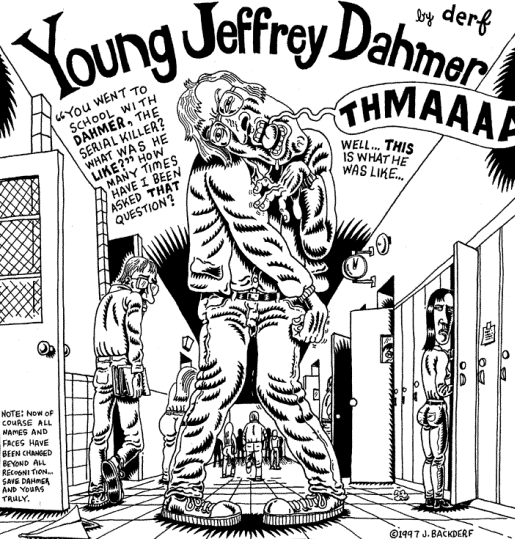
It is possibly a delusion symptomatic of my enthusiasm for Derf’s book, that I feel I’ve rarely seen something so richly incorrect as Marc Meyers’ movie. Just like the graphic novel proves about Dahmer himself, the problems begin early, and not at all subtly. The title card is chased quickly by a sort of byline, claiming that the film is “Based on a True Story”. As the rest of the film attests, this is a highly dangerous assertion. First of all, the “My” in the book’s title refers to Derf himself, and the “Friend” is meant to be ironic, according to his confession that he was among the many peers and adults who could have and should have, but did not recognize Jeffrey Dahmer as a young man in dire need of help. The book’s contents present the facts as Derf lived them, in conjunction with bitterly sympathetic suppositions about Dahmer’s personal life, derived from post-prosecution reportage. So, a film based on My Friend Dahmer should be a film about the community that responded so inappropriately, or not at all, to the challenges presented by a traumatized young alcoholic whose downward spiral led to a criminal career the likes of which the world had never seen. Meyers’ adaptation, on the other hand, is scarcely about Derf or his gang of insensitive pranksters, or anyone else in Dahmer’s culpable periphery. It is about Dahmer in a plain and simple made for TV fashion--or it might be, if it weren’t peppered with broad, frankly fake characters and events that help the director shoehorn the skeleton of Derf’s book into an unnecessary Hollywood drama that seems designed to be more digestible to a lowest common denominator audience. Artistic license is all well and good when you’re telling, say, a thinly-veiled account of a true story for your own mythological purposes. However, when you’re talking about a real person, a really famous person, whose crimes occurred within living memory, and whose kin still live alongside those whose lives he destroyed; when you shoot your movie not only in that person’s home town but in his actual childhood home; when none of the names have been changed to protect the innocent...and still you invent straw characters and events just to make a buck on your more shallow version of things, how do you find the nerve to claim that your film is based on a true story? Whose story do you even mean?
The Q&A with Meyers at the end of this Fantastic Fest screening did nothing to ease my mind.

Disney alum Ross Lynch provides one of the film’s only bright lights as Jeffrey, hurtling toward high school graduation while his interior life is deteriorating unstoppably. In a futile bid to escape the brutality of his parents’ imploding marriage, the lonesome teenage Dahmer distracts himself with a little amateur bodybuilding, dissection of roadkill, and furtive spying on a beefy jogger who regularly passes his shady family home in the woods. It seems like the young man has a shot at normality when Derf & co. respond positively to his self-effacing clowning, but this shallow reward is no match for his classmates’ homophobia, the school’s collective failure to respond to his burgeoning alcoholism and substance abuse, and his inability to create any real intimacy within or without his dysfunctional family.

Where Derf’s telling is painfully plausible when he is only speculating on Dahmer’s private existence, Meyers seems unable to trust even the known facts--though he places too much faith in his cast. Dallas Roberts does his damnedest as Jeffrey’s desperate, disconnected father, to not enough effect in his brief, disjointed scenes. (And truly, almost every scene is disjointed and too brief, due to some strange editorial choices) Anne Heche, as his wife Joyce, does little to give the proceedings depth with her typical display of frantic dithering, which evidences no directorial interference whatsoever. (The director’s claim that she is “unpredictable” and “different in every scene” is corroborated nowhere on the screen) No one else stands out in the positive or the negative other than Lynch, who one can only assume is acting under his own power; when asked by an audience member how he cast Dahmer, Meyers simply responded that he focused on kids who resembled Dahmer facially, but who also...drumroll please...can you guess the other most important characteristic?...could be about as tall as Dahmer. Their being “talented” entered the conversation as a sort of footnote, without any further discussion of what sort of presence or attitude the star should carry.

Whatever energy the director could have devoted to coaching his cast seems to have gone instead into padding the raw facts of Derf’s account with insulting inventions designed to beat the main points to death. Maybe that’s just a crutch you need if, like Meyers, you are unable to translate the novel’s devastating evocation of the Dahmer home’s oppressive atmosphere, and you must instead fill in that glaring blank with impressions of your own parents’ comparatively ordinary divorce. Maybe you feel like your depiction of Dahmer lusting after the jogger, and his alienation from women, do not prove out the young murderer’s well-known homosexuality--so you force feed your audience a chipmunk-cheeked little fellow who bafflingly shouts out the details of an upcoming date with Dahmer at the very moment when bullies are about to gay bash him into a pulp. Maybe you feel like Dahmer’s sweaty admiration of the jogger, who he stalks with a baseball bat since this person very nearly became Dahmer’s first rape-murder, isn’t a potent enough detail--so you expand this historical figure into a well-liked small town doctor to whom Dahmer goes for a would-be erotic checkup. You can make Dahmer pointedly ask whether the guy does surgery, and then you can make the medical professional implausibly sneer “I’m not the type of person who wants to cut someone open,” just before he scoffs disgustedly at his patient for (presumably) getting an erection.

Most startling of all of Meyers’ inventions is the person of Figg, a deranged bully-cum-drug dealer. Derf’s brief recollection of this person is as a sort of ridiculous but potentially dangerous hulk who was, unfortunately, not ashamed to be seen with Dahmer. In Meyers’ film, he takes up a strange amount of screen time for reasons that only became clear at the Q&A. Within the film, this disturbed individual provides Dahmer with weed, which is all well and good, but he also scares everyone with freaky nazi jokes, cuts himself and drinks his own blood like the TEXAS CHAIN SAW MASSACRE hitchhiker, and scares the shit out of Dahmer by inviting him to play russian roulette in the woods. What this is supposed to help narratively is impossible to determine. However, Meyers stressed that Figg is played by Susan Sarandon and Tim Robbins’ son Miles, and makes it abundantly clear that he happily went to great lengths to shoehorn the young man into the film. Evidently he was meant to be driving a car in some important scenes, though it was revealed that the New York-based actor does not drive. When this came up, the filmmakers wracked their brains to figure out how to keep him in the picture, only to come up with this peculiar DEER HUNTER riff. Meyers’ invitation for the audience to imagine a room full of producers puzzling over this problem, and then collectively cheering “THE DEER HUNTER!”, was not one that I could accept.

Another, in some ways more bizarre fib is committed in the context of one of the book’s most interesting recollections--the time that Jeffrey Dahmer, showing an amazing amount of pluck, weaseled himself and his friends into the office of Walter Mondale during a class field trip. The flow of this anecdote is interrupted to introduce a fantasy about Dahmer having to share a hotel room with a black varsity football player. I’d like to say here that Meyers insisted that he did absolutely no research outside of reading Derf’s novel--a dubious decision when your movie is about the real life of a real person, and when it so fails what the comic is about. To be fair, or something, Meyers said a number of troubling things about his process: That he “was just trying to make a movie set in the 70s”, that he just wanted it to be about a sort of average kid and not Dahmer the killer-to-be, that he “is not one to put any psychology on [Dahmer]”. That’s a mouthful of insistence on normality and digression and artistic license for someone whose only qualification for casting his star is that he looked just like Jeffrey Dahmer. In any case, one of the things that Meyers does to underline Dahmer’s factual homosexuality is to place him in this room with a young black athlete. In the film, Dahmer immediately begins making out-loud observations about the skin tone of different parts of the young man’s body, and asking questions about whether his entrails might be the same color as Dahmer’s. Now, anyone who knows a little bit about Dahmer knows that he almost exclusively killed athletic men of color--not so much the kinds of babyfaced white boys who are occasionally foisted upon Dahmer by Meyers. So, it’s unclear to me whether this choice is simply a bizarre accident, or an especially glib, distasteful way for Meyers to engage with his actual subject matter. In any case, it’s interruptive, uncomfortable, and difficult to understand. (For more on the grave subject of Dahmer’s impact on the poor black community in which he lived as an adult, please view the surprisingly excellent documentary THE JEFFREY DAHMER FILES)

While most of this sort of artifice seems aimed at forcing the Dahmer story to be more obvious and traditional, some of it is just unforgivable under any excuse. The film contains a sole scene that approaches something moving and truthful, in which a recently-graduated Derf happens upon Dahmer sauntering along the side of the road at night. In truth, this happened to another member of Derf’s coterie, but no matter. Derf hesitantly picks up the young man who he helped to embarrass and manipulate during their high school career, and drives him home. There they have a tense, earnestly sad exchange in the driveway, to the degree that any teenage boys are capable of having a direct conversation...and then it all goes down hill. In the film, Derf nervously joins Dahmer inside the latter’s empty house, only to back out at the last minute--AND RIGHTLY SO, BECAUSE DAHMER IS COMING AFTER HIM WITH A MURDER WEAPON! This choice is beyond despicable, as if there could be any good reason to accuse a dead man with living family of a murder that was never at risk of taking place. But, it’s also stranger than that: In Derf’s novel, it is revealed that while the friend passed a final innocent moment with Dahmer in the driveway, the fresh corpse of Dahmer’s first victim was certainly sitting either in Dahmer’s own car, or in the drainage ditch close by. Why would anyone sacrifice this powerful real life detail in favor of a cheap slasher movie scare that twists an already disturbing horror story in an unnecessary direction? I wish I had thought of this at the Q&A, but I was too busy fantasizing about asking Meyers why none of the living, suffering Dahmer family appeared in his copious list of acknowledgments at the end of the credits.
Last night I had no shortage of complaints to make, such that I could hardly sleep imagining insults to hurl. Now, I think I’ve finally emptied myself of all of the important ones. Meyer’s film is a mess, but please don’t let it prevent you from reading Derf’s moving and truthful novel, in which there is at least a payoff for all of the pain.
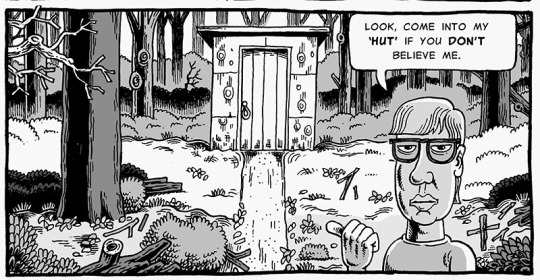
#derf backderf#my friend dahmer#marc meyers#ross lynch#adaptation#graphic novel#jeffrey dahmer#true crime#memoir#serial killer#blogtober
116 notes
·
View notes
Text
NXT TakeOver: Brooklyn III (August 20 2017)
The first thing I saw coming out of the Atlantic Center - Barclays Center stop was a group of fans posing for some pre-roll footage for WWE or a local news show’s use. Chanting “NXT” and posing in mock menace, the crowd was only of interest to me because they blocked the sidewalk and my path to join two friends at Don Chignon for a pre-show meal and cocktail.
Last week, I attended Evolve 91 and PROGRESS NYC at a youth recreational center in Corona, Queens. This week, I attended TakeOver: Brooklyn III at the Barclays Center, which is as different from the Elmcor Youth Center as the temperature was in the two buildings on two different August evenings. However, the similarities are worth a chuckle. At both shows, there were fans who were just a little socially awkward, who tried a little too hard to start chants that would go nowhere to prove that they know all about the wrestlers. At both shows, cameramen had spotters clad in black who had to make sure that the camera operators would be able to travel around the ring and film everything. At one point, there were technical difficulties at the Barclays Center that was only different than the technical difficulties an independent wrestling show might suffer by dint of scale. And I’m sure that fourth row floor seats at the Barclays Center wouldn’t have been that much better than fourth row floor seats at the Elmcor Youth Center.
So, I was glad that we were in the arena’s upper bowl in seats that had clear sight lines of the entrance ramp and the ring. The only obstacle to a good view would be my fellow fans in the row before ours who would stand up to record everything on their phones. I don’t know if the WWE tried to pretend that this was a full house, but there were many empty seats across from me on the hard camera side even by the main event. It corroborates reports that the secondary market for TakeOver tickets has fallen through the floor.
Before the show started, they played a backstage interview segment where Renee asked Becky Lynch and Bayley who they thought would win the NXT Women’s Championship match. Lynch received her usual cheers, but the crowd was surprisingly vocal about their dislike for Bayley. I’m surprised that the crowd has turned on Bayley, but character stagnation and character assassination will turn even the easiest going babyface into someone that the crowd hates. I suppose that Bayley can turn back, but it’s disappointing to see Bayley’s potential so thoroughly squandered.
The pre-show had an aborted No Way Jose vs. Lars Sullivan match, a perfectly acceptable Peyton Royce vs. Sara Logan match, and a surprise appearance from Tyler Bate, Trent Seven, Wolfgang, and Pete Dunne. The cheers for Bate and Dunne were genuine because the match was unannounced, and the match told a fun story about how Bate and Dunne Were evenly matched. Therefore, Dunne and Wolfgang focused their attack on Trent Seven to eliminate him from the match. With Seven out of the way, Dunne and Wolfgang could work over Bate at length and even use a blind tag to allow Wolfgang to hit a swanton bomb that took Bate by surprise and score Wolfgang the victory. There were two separate “This is Progress” chants during the match, which amused me. A friend asked me if Dunne would attack Wolfgang after the match, and I responded that he doesn’t have a reason to be a dick for no reason, which is some kind of impressive logic trap.
1. Johnny Gargano vs. Andrade Cien Almas w/Zelina Vega
I hadn’t realized that they had added lyrics to Johnny Gargano’s entrance theme, which is an unfortunate choice. The crowd loves Gargano, while no one clapped for or booed against Almas; the “Johnny Wrestling” chants supported Gargano, and that Almas was wrestling Gargano was irrelevant to the fans early. There was one “Los Ingobernables” sign by the entrance ramp, and I wondered if I were the only one who appreciated the fact that both Tetsuya Naito, leader of Los Ingobernables de Japon, and Almas, former leader of Los Ingobernables, have really energetic music that belie their “tranquilo” attitudes. Gargano looked to use his speed to take Almas off guard with some crisp mat wrestling early in the match, but Almas kicked out at one. Gargano and Almas combined a little bit of everything, from American independent mat wrestling to lucha libre to Japanese strike exchanges into some really great sequences; Gargano’s La Mistica transition into the Garga-No Escape that then led to Almas rolling through and powerbombing Gargano was one of the hottest moments for an energetic crowd. I also respected the fact that Almas worked on Gargano’s left arm throughout the match, and Gargano was smart enough to adjust his position so that he would use the right arm when he and Almas hit their double clothesline spot. They say that there is a great woman behind every great man, so Zelina Vega seems to be taking a shot at becoming the great woman behind Almas by interfering on Almas’s behalf during the match. After Gargano hit a pair of superkicks and threw Almas into the second turnbuckle like a lawn dart, Vega threw a “#DIY” shirt at Gargano, which distracted him long enough for Almas to stun him and hit a hammerlock DDT to score the victory. This was an incredible opener, and it was a great reminder that, even if the card looks underwhelming on paper, TakeOver shows are usually great in the ring. And, as I commented to my friend, the build to the eventual Tommaso Ciampa and Gargano feud will be incredible.
2. NXT Tag Team Championship match: The Authors of Pain (Akam & Rezar) (c) w/Paul Ellering vs. Sanity (Eric Young & Alexander Wolfe) w/Nikki Cross and Killian Dain
I still can’t tell Akam and Rezar apart, so I hope that they do something to differentiate them at some point. It’s also possible that I just need to pay closer attention. It’s hard to find an emotional connection to a match that features a monster tag team that destroyed fan favorites like American Alpha, the Revival, and #DIY and an aggressively discordant faction like Sanity. In the end, Wolfe’s surprising performance and Nikki Cross’s enthusiasm ringside led me to root for Sanity. Because Wolfe looks like a second tier villain on a good season of Justified, it’s easy to forget that he’s actually a good in-ring wrestler. Young, who looks like he would also fit in Boyd Crowder’s gang, is an experienced tag team wrestler, so it almost made sense that he would insert himself into the match in Dain’s place. Dain, of course, would make all of these seem sensible later in one of the most impressive moments of the night when he hits a crossbody splash on the Author of Pain who had caught Nikki Cross after her dive from the top rope to the floor, sandwiching Cross between the Author and Dain and driving all three through a table. They protected Cross as well as they could in that spot, and it eliminated one Author to allow Young and Wolfe to double team the other Author and win the titles. The match exceeded my admittedly low expectations, and Cross played a major role in investing me into Sanity for the match. I also like the idea that Young outsmarted Ellering by announcing that Wolfe and Dain would wrestle and changing the line-up at the last moment by inserting himself into the match. The thrill of that victory was short-lived, however, when Bobby Fish and Kyle O’Reilly, reDRagon, appeared from the crowd to attack Young and Wolfe, hitting their finisher Chasing the Dragon on Young. reDRagon’s surprise appearance and declaration of intent gave the crowd another boost and made me enthusiastic about the future of tag team wrestling in NXT. I’m curious how Corey Graves contributed to the televised experience as a guest commentator.
3. Aleister Black vs. Hideo Itami
I had very high expectations for this match because I wanted to see Black and Itami have a stiff, strike-heavy, faux-MMA style match. At first, I was disappointed to see Black once again absorb so much offense from Itami without responding, but then I started thinking about his entrance theme, which was ably performed by WWE’s musical guest for the evening, Code Orange. (For tonight, at least, Code Orange is the new performer for Black’s theme.) Black, through his theme, challenges this opponents to do their worst:
“No man is ever truly good No man is every truly evil I do the things you never could And we won't ever be equal No man is ever truly good No man is every truly evil I do the things you never could And we won't ever be equal You point your finger and play the victim So take your best shot Release the pressure You perpetrate your propaganda And now I'm calling you out”
(Black’s theme, “Root of All Evil,” is a great half a song.) Itami, beset by bad luck and worse health, probably feels like a victim of circumstances. He took his best shot at Black and tried to wear Black down with kicks, chops, a top rope Falcon Arrow, and a second Falcon Arrow. He tried to wear Black down on the mat with a long chinlock sequence when his strikes couldn’t finish Black. Then, Black called him out with the Black Mass roundhouse head kick, and Itami was down for the three count. It was a hard-hitting match, but Black’s matches have lacked drama because he absorbs damage until it’s time for him to hit the Black Mass to end the match. I joked when they announced that Jim Ross would be the special guest announcer for this match that they must be trolling him after he had such a hard time distinguishing wrestlers and pronouncing names at the New Japan Pro Wrestling G1 Specials.
4. NXT Women’s Championship match: Asuka (c) vs. Ember Moon
Part of the live experience is seeing wrestlers who don’t emerge from backstage during their entrances get into position on the stage while the rest of the crowd is supposed to be paying attention to the recap that’s played on the big screens. Similarly, I was fascinated by the little production touches throughout the show, like the fact that the camera operator has to stand on a ladder in order to film the commentators in their talking head segments between matches or the fact that a member of the production staff has to remove Percy Watson’s and Nigel McGuinness’s chairs before those segments and replace them immediately after.
Similarly, watching them shuttle guests to the front row seats for their promotional appearances was fascinating to me. I wonder how long Lynch, Sasha Banks, and Bayley can trade on their history as the Four Horsewomen of NXT (Charlotte was conspicuous in her absence for understandable reasons). The fact that the crowd booed Bayley would show that lifespan of the warm and fuzzy feelings of those memories is not as long as you would think.
Because Asuka debuted after Banks, Charlotte, and Lynch had moved on from NXT (her first match was against Dana Brooke at NXT TakeOver: Respect, which was headlined by the 30 Minute Ironwoman match between Bayley and Banks, the last match involving the Four Horsewomen), Asuka doesn’t have the same connection with fans that Banks, Lynch, Charlotte, and Bayley have. The crowd’s unsure reaction to Asuka’s victory over Bayley to win the NXT Women’s Championship at TakeOver: Dallas made that clear. That said, the NXT crowd connected to Asuka through her swagger (no one, not even Banks at her peak, could match the sense of cool that Asuka projects during her entrances), ferocity (not even Lynch could match the violence that Asuka could unleash), or dominance (not even Charlotte or Banks could project Asuka’s sense of invincibility).
The crowd was even split between Moon supporters and Asuka fans. Moon attacked Asuka from the bell, and Asuka had to regroup outside the ring. The action is incredible and too quick for anyone to realistically recap. It was best to let the match wash over you and take part in the spontaneous and loud dueling chants for the two women. Asuka targeted Moon’s surgically repaired arm, and the two trade incredibly stiff strikes to the crowd’s delight. This sums up the crowd’s reaction when Moon hit the Eclipse:
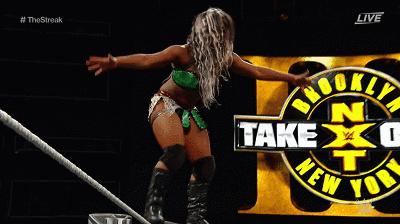
As a fan of Asuka, I was overjoyed when Asuka kicked out from the Eclipse and kicked out again after a Moon superkick. I was cheering my lungs out when Asuka had trapped Moon in the Asuka Lock and when Asuka forced Moon to finally submit in the middle of the ring. There is enough wiggle room from controversy to justify one more rematch since Asuka shielded herself from a second Eclipse by cowering behind the referee, but the way Moon soaked up the appreciative applause from the crowd after the match seemed like a conclusion for Moon in NXT. Meanwhile, I can continue to enjoy Asuka as the unbeatable champion. This was the match of the night, followed closely by Gargano vs. Almas, and I joked to my friend that it wouldn’t be an NXT TakeOver: Brooklyn show if they didn’t put the wrong match in the main event slot. Bayley vs. Banks should have been the main event of TakeOver: Brooklyn, and the Revival vs. #DIY should have been the main event of TakeOver: Brooklyn II. This should have been the main event of TakeOver: Brooklyn III. It was magnificent.
I also really enjoyed the little touch of Asuka staring at and taunting Lynch, Banks, and Bayley throughout the match. Seeing Asuka confront her predecessors in NXT put the entire match in context.
5. NXT Championship match: Bobby Roode (c) vs. Drew McIntyre
A surefire way to make me lose interest in a match is to trot out the NYPD to escort the nominal face in the match to the ring. I’m sure getting the NYPD Emerald Society to play the bagpipes for McIntyre’s performance seemed like a stroke of genius, but all it did was to make me (and a few other black and brown fans in my section) sit down and not care about McIntyre. Combined with the emotional fatigue after the Asuka vs. Moon match and Roode’s match style, which can be charitably called methodical, and I was more disengaged than bored during the match. It’s not as if the last match had completely worn the crowd down; Samoa Joe received very loud “Joe!” chants during his brief appearance ringside to promote his championship four way match at SummerSlam 2017. Roode’s match style gives the crowd very little to chew on, and McIntyre’s hard-hitting style could only provide so much flavor to the match. As the match began, the fans behind me waxed poetic about TNA”s short period when that company approached greatness, reminiscing about the heyday of the X Division and cursing Hulk Hogan for his perceived role in the company’s decline. McIntyre popped the crowd with a tope con hilo that Roode failed to catch him on, and it led to a pretty good closing section highlighted by Roode’s backstabber (my friend asked if he hit a Codebreaker, to which I replied that it was a Roode-a-bager because my Dad joke game is strong), McIntyre’s Future Shock DDT, Roode’s Glorious DDT, and the Claymore. I liked that Roode was hoisted on his own petard by trying to hit more than one Glorious DDT to ensure his victory, which allowed McIntyre to recover just long enough to hit the Claymore to win the match and the championship. It was a fine match, but it will be overshadowed by Asuka vs. Moon, and it would be remembered mostly for the post-match attack by reDRagon and a debuting Adam Cole.
This was a really enjoyable show, and it proves once again that TakeOver shows should not be underestimated and that wrestling shows have a sweet spot about two and a half hours.
#WWE#nxt#nxt takeover#takeover brooklyn#nxt takeover brooklyn#nxt takeover brooklyn iii#johnny gargano#andrade cien almas#the authors of pain#sanity#paul ellering#nikki cross#eric young#alexander wolfe#killian dain#hideo itami#code orange#aleister black#ember moon#asuka#bobby roode#drew mcintyre#Wrestling#pro wrestling
7 notes
·
View notes
Link
For more than three weeks, progressive activists and women's rights advocates debated how to handle an allegation of sexual assault against Joe Biden. The conversations weren't easy, nor were the politics: Biden, the presumptive Democratic presidential nominee, faced one allegation; his opponent, President Donald Trump, at least a dozen.Finally, several of the women's groups prepared a public letter that praised Biden's work as an "outspoken champion for survivors of sexual violence" but also pushed him to address the allegation from Tara Reade, a former aide who worked in Biden's Senate office in the early 1990s."Vice President Biden has the opportunity, right now, to model how to take serious allegations seriously," the draft letter said. "The weight of our expectations matches the magnitude of the office he seeks."Then Biden's team heard about the advocates' effort. According to people involved in the discussions, the group put the letter on hold as it began pressuring Biden advisers to push the candidate to make a statement himself before the end of April, which is Sexual Assault Awareness Month. Along with liberal organizers, they urged him to acknowledge the importance of survivors and the need for systemic change around issues of sexism and assault.Nearly two weeks later, Biden and his campaign have yet to make that statement, and the advocates have not released their letter. The Biden campaign has said little publicly beyond saying that women deserve to be heard and insisting that the allegation is not true; privately, Biden advisers have circulated talking points urging supporters to deny that the incident occurred.As two more women have come forward to corroborate part of Reade's allegation, the Biden campaign is facing attacks from the right and increasing pressure from the left to address the issue. And liberal activists find themselves in a tense standoff with a candidate they want to support but who they say has made little attempt to show leadership on an issue that resonates deeply with their party's base."It's difficult for survivors to see that a woman who has more corroborating sources than most survivors have in similar situations is being tossed aside and actively being weaponized by cynical political actors," said Shaunna Thomas, a founder of UltraViolet, a women's rights advocacy group that is involved in the effort to push the campaign. "It would be an incredible moment of leadership for Joe Biden to show up."Since Reade spoke out in March with her allegation -- that Biden penetrated her with his fingers in a Senate building in 1993 -- his aides and advisers have denied it, saying it is "untrue." They have remained unconcerned about any significant political blowback from Reade's accusation, according to people who have spoken with the campaign, who insisted on anonymity to discuss private conversations.Top Biden aides are telling allies that they do not see the allegation resonating with voters in a measurable way, these people say. They're confident that the allegation will not shake voters' perceptions of Biden's character as a devoted father and husband, with family ties forged through deep tragedies. They also believe that voters will view the allegation with great skepticism.A Biden campaign spokesman declined to comment for this article Wednesday. A Biden adviser said that the campaign was talking to activists and that Biden considered their views important.The Biden campaign talking points, which were first reported by BuzzFeed News, instruct supporters to describe the candidate as a "fierce advocate for women" who has never faced any "complaint, allegation, hint or rumor of any impropriety or inappropriate conduct." The talking points also inaccurately suggested that an investigation by The New York Times this month found that "this incident did not happen."In a statement issued Wednesday, The Times noted that the investigation "made no conclusion either way."One person who received a version of these talking points said it was pulled back by the campaign several hours later because the campaign was revising its strategy. The person spoke on the condition of anonymity to disclose the private communication.Biden has yet to be asked about the allegation in an interview. In a joint appearance with Hillary Clinton that was livestreamed on his website Tuesday, he discussed domestic violence, economic challenges facing women and the stresses of the coronavirus pandemic. No mention was made of Reade or her specific allegation."Violence against women is a huge problem, and especially right now," he said. Ending violence against women has "been one of the leading causes of my life," he added.His campaign Tuesday also released plans to support women during the coronavirus crisis that included proposals to help victims of domestic violence.In recent months, Biden has taken steps that appear to show he understands how a commitment to representation and equity might resonate with women, who make up the majority of voters for Democratic candidates. He has pledged to pick a woman as a running mate and nominate a black woman to the Supreme Court.Yet as he seeks to unite the Democratic Party after the primaries and pivot to a general election against Trump, Reade's allegation remains a subject of intense discussion in the political world.Republicans and the Trump campaign are already using the accusation to undercut Biden and the Democratic Party as hypocritical on issues of gender equity. Some in the party's liberal wing have seized on Reade's account, saying she should be heard and using her allegation to argue that Biden is not the party's strongest possible nominee -- a tactic that Biden backers fear could hamper their ability to build Democratic enthusiasm around his bid."It can't appear that she is being ignored," said Nina Turner, a former national campaign co-chair for Sen. Bernie Sanders, Biden's last rival for the nomination. "If we want to keep our credibility as a party, then we will have to agree that this allegation and any allegation should be vetted in the public."Apart from the discussions with the campaign, some progressive activists have been debating how to respond to the allegation, a conversation that has intensified in recent days."Joe Biden himself needs to respond directly," said Yvette Simpson, the chief executive of Democracy for America, a progressive advocacy organization, which plans to back the Democratic nominee. "While it is absolutely essential that we defeat Donald Trump in November, trying to manage the response through women surrogates and emailed talking points doesn't cut it in 2020 -- especially if Democrats want to continue to be the party that values, supports, elevates, hears and believes women."There has been no public polling on how voters are viewing the specific allegation, though surveys show that among voters who dislike both candidates, significantly more prefer Biden.Tresa Undem, a pollster who specializes in surveys on gender issues, said that so far the allegation hasn't dampened support for Biden among Democrats. But that could change quickly, she said, depending on how Biden and his campaign handle the evolving situation."If the election was held today, I don't think he'd lose any support," she said. "But this is a huge deal that's not going away. The story is going to be on the hypocrisy, and that is the No. 1 thing voters loathe."Among Republicans, the years of allegations against Trump have inflicted little damage with his base. He has been accused of sexual assault and misconduct by more than a dozen women, who have described behavior that went far beyond the allegation against Biden. He has repeatedly denigrated women over their appearance and intellect. The "Access Hollywood'' tape, in which he boasted about grabbing women's genitals, was released just weeks before his victory in the 2016 election.In recent years, Democrats have sought to confront current and past misconduct in their own ranks and spoken bluntly about racial and gender inequalities.Already, the allegation against Biden has caused top female allies -- including several widely considered to be vice-presidential prospects, like Stacey Abrams of Georgia and Sen. Amy Klobuchar of Minnesota -- to face questioning about whether they stand with Biden after the allegation. Privately, some female Democrats are growing frustrated with being put in the position of answering for Biden when he has remained silent, and male progressive leaders, even outspoken allies in combating sexual assault, have not been pressured to address this point.Many have publicly defended him, including Sen. Kirsten Gillibrand of New York, who helped lead the effort to push Al Franken, the former Minnesota senator, to resign over sexual harassment accusations in 2017. "I stand by Vice President Biden," Gillibrand said on a conference call, adding there needed to be "space for all women to come forward to speak their truth, to be heard."Last year, Reade was one of eight women who came forward to say Biden had kissed, hugged or touched them in ways that made them feel uncomfortable, but she did not raise the assault allegation then.In an interview Tuesday, Reade described herself as disappointed with the response from the Biden campaign, saying it had not contacted her. Reade backed Sanders in the primary race and does not plan to vote in the general election. She told The Times that politics were not the reason she came forward with her allegation, saying she did not want to be used by the Trump campaign."Sexual assault and sexual harassment in the workplace is a huge gender, institutionalized problem in our country, and the fact that they are not addressing my allegations head-on and dealing with the corroborating evidence is simply a testimony to the hypocrisy," she said. "There is no partisanship with sexual assault and harassment. It is an equal opportunity offender."Last week, The Intercept published a transcript of a call that aired on a Larry King program between a woman living in California and King. The woman was seeking advice about what her daughter could do about "problems" she had while working for a "prominent senator" but did not specifically mention sexual assault or harassment. Reade has previously said her mother, who has since died, called into the program after she told her about her experience.Two women also came forward in an article this week in Business Insider to corroborate parts of Reade's account.One of the women, Lynda LaCasse, a former neighbor of Reade's, said in an interview with The Times on Tuesday that Reade told her around 1995 about her encounter with Biden. LaCasse said she and Reade had been discussing their experiences with abuse and violence when Reade mentioned Biden."She said that he put her up against the wall and he put his hand up her skirt and he put his fingers inside her," LaCasse said, adding that Reade "was devastated. She sounded really upset. She was crying."LaCasse, who is now 60 and lives in Oregon, said she was a Democrat and supported Biden. But she said she wanted to come forward because "that doesn't take away from what happened."The second woman, Lorraine Sanchez, a former colleague of Reade's in the mid-1990s, said she recalled Reade describing an incident of harassment by her former boss. She provided a statement outlining her account to The Times.Former Sen. Barbara Boxer of California, who has endorsed Biden, said in an interview that she thought the campaign had handled Reade's allegation "well" and that it had "done everything that they can do." She said the Biden campaign had not given her talking points."If they ask me my advice," she said, "it would be keep on doing what they're doing."This article originally appeared in The New York Times.(C) 2020 The New York Times Company
from Yahoo News - Latest News & Headlines https://ift.tt/3bSB8nv
0 notes
Link
For more than three weeks, progressive activists and women's rights advocates debated how to handle an allegation of sexual assault against Joe Biden. The conversations weren't easy, nor were the politics: Biden, the presumptive Democratic presidential nominee, faced one allegation; his opponent, President Donald Trump, at least a dozen.Finally, several of the women's groups prepared a public letter that praised Biden's work as an "outspoken champion for survivors of sexual violence" but also pushed him to address the allegation from Tara Reade, a former aide who worked in Biden's Senate office in the early 1990s."Vice President Biden has the opportunity, right now, to model how to take serious allegations seriously," the draft letter said. "The weight of our expectations matches the magnitude of the office he seeks."Then Biden's team heard about the advocates' effort. According to people involved in the discussions, the group put the letter on hold as it began pressuring Biden advisers to push the candidate to make a statement himself before the end of April, which is Sexual Assault Awareness Month. Along with liberal organizers, they urged him to acknowledge the importance of survivors and the need for systemic change around issues of sexism and assault.Nearly two weeks later, Biden and his campaign have yet to make that statement, and the advocates have not released their letter. The Biden campaign has said little publicly beyond saying that women deserve to be heard and insisting that the allegation is not true; privately, Biden advisers have circulated talking points urging supporters to deny that the incident occurred.As two more women have come forward to corroborate part of Reade's allegation, the Biden campaign is facing attacks from the right and increasing pressure from the left to address the issue. And liberal activists find themselves in a tense standoff with a candidate they want to support but who they say has made little attempt to show leadership on an issue that resonates deeply with their party's base."It's difficult for survivors to see that a woman who has more corroborating sources than most survivors have in similar situations is being tossed aside and actively being weaponized by cynical political actors," said Shaunna Thomas, a founder of UltraViolet, a women's rights advocacy group that is involved in the effort to push the campaign. "It would be an incredible moment of leadership for Joe Biden to show up."Since Reade spoke out in March with her allegation -- that Biden penetrated her with his fingers in a Senate building in 1993 -- his aides and advisers have denied it, saying it is "untrue." They have remained unconcerned about any significant political blowback from Reade's accusation, according to people who have spoken with the campaign, who insisted on anonymity to discuss private conversations.Top Biden aides are telling allies that they do not see the allegation resonating with voters in a measurable way, these people say. They're confident that the allegation will not shake voters' perceptions of Biden's character as a devoted father and husband, with family ties forged through deep tragedies. They also believe that voters will view the allegation with great skepticism.A Biden campaign spokesman declined to comment for this article Wednesday. A Biden adviser said that the campaign was talking to activists and that Biden considered their views important.The Biden campaign talking points, which were first reported by BuzzFeed News, instruct supporters to describe the candidate as a "fierce advocate for women" who has never faced any "complaint, allegation, hint or rumor of any impropriety or inappropriate conduct." The talking points also inaccurately suggested that an investigation by The New York Times this month found that "this incident did not happen."In a statement issued Wednesday, The Times noted that the investigation "made no conclusion either way."One person who received a version of these talking points said it was pulled back by the campaign several hours later because the campaign was revising its strategy. The person spoke on the condition of anonymity to disclose the private communication.Biden has yet to be asked about the allegation in an interview. In a joint appearance with Hillary Clinton that was livestreamed on his website Tuesday, he discussed domestic violence, economic challenges facing women and the stresses of the coronavirus pandemic. No mention was made of Reade or her specific allegation."Violence against women is a huge problem, and especially right now," he said. Ending violence against women has "been one of the leading causes of my life," he added.His campaign Tuesday also released plans to support women during the coronavirus crisis that included proposals to help victims of domestic violence.In recent months, Biden has taken steps that appear to show he understands how a commitment to representation and equity might resonate with women, who make up the majority of voters for Democratic candidates. He has pledged to pick a woman as a running mate and nominate a black woman to the Supreme Court.Yet as he seeks to unite the Democratic Party after the primaries and pivot to a general election against Trump, Reade's allegation remains a subject of intense discussion in the political world.Republicans and the Trump campaign are already using the accusation to undercut Biden and the Democratic Party as hypocritical on issues of gender equity. Some in the party's liberal wing have seized on Reade's account, saying she should be heard and using her allegation to argue that Biden is not the party's strongest possible nominee -- a tactic that Biden backers fear could hamper their ability to build Democratic enthusiasm around his bid."It can't appear that she is being ignored," said Nina Turner, a former national campaign co-chair for Sen. Bernie Sanders, Biden's last rival for the nomination. "If we want to keep our credibility as a party, then we will have to agree that this allegation and any allegation should be vetted in the public."Apart from the discussions with the campaign, some progressive activists have been debating how to respond to the allegation, a conversation that has intensified in recent days."Joe Biden himself needs to respond directly," said Yvette Simpson, the chief executive of Democracy for America, a progressive advocacy organization, which plans to back the Democratic nominee. "While it is absolutely essential that we defeat Donald Trump in November, trying to manage the response through women surrogates and emailed talking points doesn't cut it in 2020 -- especially if Democrats want to continue to be the party that values, supports, elevates, hears and believes women."There has been no public polling on how voters are viewing the specific allegation, though surveys show that among voters who dislike both candidates, significantly more prefer Biden.Tresa Undem, a pollster who specializes in surveys on gender issues, said that so far the allegation hasn't dampened support for Biden among Democrats. But that could change quickly, she said, depending on how Biden and his campaign handle the evolving situation."If the election was held today, I don't think he'd lose any support," she said. "But this is a huge deal that's not going away. The story is going to be on the hypocrisy, and that is the No. 1 thing voters loathe."Among Republicans, the years of allegations against Trump have inflicted little damage with his base. He has been accused of sexual assault and misconduct by more than a dozen women, who have described behavior that went far beyond the allegation against Biden. He has repeatedly denigrated women over their appearance and intellect. The "Access Hollywood'' tape, in which he boasted about grabbing women's genitals, was released just weeks before his victory in the 2016 election.In recent years, Democrats have sought to confront current and past misconduct in their own ranks and spoken bluntly about racial and gender inequalities.Already, the allegation against Biden has caused top female allies -- including several widely considered to be vice-presidential prospects, like Stacey Abrams of Georgia and Sen. Amy Klobuchar of Minnesota -- to face questioning about whether they stand with Biden after the allegation. Privately, some female Democrats are growing frustrated with being put in the position of answering for Biden when he has remained silent, and male progressive leaders, even outspoken allies in combating sexual assault, have not been pressured to address this point.Many have publicly defended him, including Sen. Kirsten Gillibrand of New York, who helped lead the effort to push Al Franken, the former Minnesota senator, to resign over sexual harassment accusations in 2017. "I stand by Vice President Biden," Gillibrand said on a conference call, adding there needed to be "space for all women to come forward to speak their truth, to be heard."Last year, Reade was one of eight women who came forward to say Biden had kissed, hugged or touched them in ways that made them feel uncomfortable, but she did not raise the assault allegation then.In an interview Tuesday, Reade described herself as disappointed with the response from the Biden campaign, saying it had not contacted her. Reade backed Sanders in the primary race and does not plan to vote in the general election. She told The Times that politics were not the reason she came forward with her allegation, saying she did not want to be used by the Trump campaign."Sexual assault and sexual harassment in the workplace is a huge gender, institutionalized problem in our country, and the fact that they are not addressing my allegations head-on and dealing with the corroborating evidence is simply a testimony to the hypocrisy," she said. "There is no partisanship with sexual assault and harassment. It is an equal opportunity offender."Last week, The Intercept published a transcript of a call that aired on a Larry King program between a woman living in California and King. The woman was seeking advice about what her daughter could do about "problems" she had while working for a "prominent senator" but did not specifically mention sexual assault or harassment. Reade has previously said her mother, who has since died, called into the program after she told her about her experience.Two women also came forward in an article this week in Business Insider to corroborate parts of Reade's account.One of the women, Lynda LaCasse, a former neighbor of Reade's, said in an interview with The Times on Tuesday that Reade told her around 1995 about her encounter with Biden. LaCasse said she and Reade had been discussing their experiences with abuse and violence when Reade mentioned Biden."She said that he put her up against the wall and he put his hand up her skirt and he put his fingers inside her," LaCasse said, adding that Reade "was devastated. She sounded really upset. She was crying."LaCasse, who is now 60 and lives in Oregon, said she was a Democrat and supported Biden. But she said she wanted to come forward because "that doesn't take away from what happened."The second woman, Lorraine Sanchez, a former colleague of Reade's in the mid-1990s, said she recalled Reade describing an incident of harassment by her former boss. She provided a statement outlining her account to The Times.Former Sen. Barbara Boxer of California, who has endorsed Biden, said in an interview that she thought the campaign had handled Reade's allegation "well" and that it had "done everything that they can do." She said the Biden campaign had not given her talking points."If they ask me my advice," she said, "it would be keep on doing what they're doing."This article originally appeared in The New York Times.(C) 2020 The New York Times Company
from Yahoo News - Latest News & Headlines https://ift.tt/3bSB8nv
0 notes
Link
It is hard to believe that the run-up to the presidential-election year has plumbed such a depth of farcical degradation. It must be that Trump’s influence has contributed to unserious responses, but he can’t be blamed for the unutterable nonsense of his opponents and the straight men of the political class that has absorbed the shock of the Trump phenomenon. Monday, December 9, had been much anticipated. Congressman Jerry Nadler, who has not been able to utter a sentence in the last three years that did not contain the word “impeachment,” gaveled to order his asinine Judiciary Committee hearings to consider the partisan recommendation of Adam Schiff’s Intelligence Committee that the president had abused his powers by asking about what must concern the endangered minority that takes former vice president Joe Biden’s run for the Democratic presidential nomination seriously. Trump asked the Ukrainian president to find out whether Biden and his son were influence-peddling in Ukraine. Trump didn’t try to write the verdict of his inquiry; he asked a reasonable question. The Democrats, if any of them retain their sanity despite the simulation of a lunatic asylum their party is conducting, would be at least as curious as the Republicans to hear the answer. Last week Nadler had four constitutional experts before the committee, including three rabid Trump haters, one so overwrought that she couldn’t walk on the sidewalk in front of Washington’s Trump Hotel.While this impeachment charade has bounced between the two most compulsively mendacious legislators in the Western world, Speaker Nancy Pelosi has been giving daily recitals of her “prayerful solemnity” at the dark majesty of the impeachment process that saddens her so deeply. She has invoked her Roman Catholic faith (tempered in its fervor by enthusiasm for abortion and other doctrinal inconveniences from the theology of St. Teddy Kennedy and the Blessed Joe Biden) to say she “hates” no one and “prays for the president.” This was enough to bring on what seemed to be out-of-body epiphanies with the susceptible pundits on cable television, such as Rachel Maddow and Larry O’Donnell of MSNBC: “The speaker stood there, in the Catholic faith she has practiced all her life,” etc. The result is nausea and amusement conjoined. As a very young person, I remember when the time came that all sensible opinion required the end of the outrages of Senator Joseph R. McCarthy, and the time 20 years later when the Watergate controversy simply had to end. The coruscation of the present foolishness must be almost at hand. The Democrats are rushing to an impeachment committal requiring adjudication by the Senate, though no statutory offense has been alleged against the president, and there is no evidence of any. One hesitates to mind-read, especially such febrile and limited minds as these, but they presumably want to throw this stink bomb at the president to foul the air as the proportions of the previous administration’s misconduct in the Trump–Russia collusion scam ooze sluggishly into the light.The inspector general of the Justice Department, Michael Horowitz, again gave birth to a mouse. His report released Monday purported to believe that those who initiated the investigation of the president were not motivated by partisanship, though they all hated the subject of the investigation (at least they and Mr. Horowitz spared us the treat of representing Trump’s tormentors as Pelosian bead-rattling rosarians raising supplications heavenwards for the man they were trying to crucify). Unfortunately, he did not offer an alternative motive for a staggering sequence of frauds and felonies committed by the Obama Justice Department and FBI. The following is a faithfully representative selection of the inspector general’s concerns.The conduct of former deputy attorneys general Sally Yates and Rod Rosenstein “were inconsistent with or undercut the assertions contained in the FISA applications” (to conduct surveillance on Trump-campaign helper Carter Page). They contained “inaccurate information,” i.e. the applications were fraudulent. Christopher Steele, the author of the infamous Steele Dossier, a pastiche of defamatory fabrications that was paid for by the Clinton campaign and was the principal basis of the FISA (Foreign Intelligence Surveillance Act) applications, thought he was answerable to paying clients (the Clinton campaign and the Democratic National Committee, through a law firm and the dirty-tricks operation Fusion GPS), while the FBI thought he was answerable to the Bureau, despite having closed out Steele for cause for assisting Fusion GPS in getting his false allegations into the media. Yet he continued to feed information to the FBI through the wife of senior Justice Department official Bruce Ohr; she was contracted to Fusion GPS. Steele met 13 times with Mrs. Ohr after Steele’s termination by the FBI, and his information was fed to the FBI. Steele continued to supply information to the FBI that director James Comey and deputy director Andrew McCabe wanted to include in the Intelligence Community Assessment of these matters (at least that outrage was not approved, but their effort incites intense curiosity about Horowitz’s imputation of motives). “Ohr committed consequential errors in judgment” and a (prolonged) “lapse of judgment,” Horowitz writes.The FBI “failed to reassess” Steele’s information and denied to the FISA court that Steele had “directly provided” information for a false Yahoo story linking Trump and Russia on September 23, 2016, for which the Bureau fired Steele as a “confidential human source.” Steele played a “central and essential role” in obtaining the FISA authorizations and was represented to the court as “a reliable source” even though his own handler warned Comey and McCabe that Steele was not reliable and was uncorroborated, and that his principal sub-source was “a boaster, egoist . . . [who] embellishes,” according to Steele himself. Yet the source was asserted to the FISA court to be “truthful and cooperative.”The FBI omitted to tell the FISA court that Carter Page was an approved “operational contact” with another branch of government and had loyally supplied any information he had about Russian activities. George Papadopoulos, another victim of the Comey-McCabe Keystone Kops smear operation, was cited in FISA applications, but not his repeated assertions that there was no evidence of any Trump involvement with Russia. Carter Page was selectively and misleadingly cited to the court throughout the period when he was under surveillance. His helpful reports of financial irregularities in the international soccer federation were misrepresented as evidence of Page’s untrustworthiness; he was shamefully traduced, as Horowitz demonstrates in great detail. The FBI’s Validation Management Unit debunked Steele as, inter alia, “minimally corroborated,” but he continued to be reverently invoked in FISA court filings. There were a number of confidential human sources who happened to be working loyally for the Trump campaign, but none of them were consulted or questioned, though they were proven FBI resources.Horowitz concluded that there were “17 significant errors” in the FISA renewal applications, but he was unable to discover when Comey, McCabe, and Yates became aware of all these problems, only that they “did not have accurate information when they approved supplementary FISA applications.” It is impossible to imagine that he made a very strenuous effort to answer that question. He limply concludes this hair-raising revelation of scandalous and massive official wrongdoing by urging senior Justice and FBI officials to take “any action they deem appropriate.”It is clear from the statements of demurral from Horowitz’s absurdly bland conclusions by attorney general William Barr and special prosecutor John Durham that they do not share his confidence in the motives and probity of a broad swath of the Justice Department and FBI, from the highest ranks to quite junior people. It is obvious from the report itself that horrifying misdeeds were committed, and that the FBI was careening out of control and meddling in the electoral process illegally as well as incompetently. Since this is his second effort to string out and partially whitewash with humdrum verbosity the revelation of shocking violations of law and duty by senior Justice officials, Horowitz’s head should roll with the others in due course, and be replaced by someone more energetic in scorching out such monstrous misconduct as he thoroughly reports.James Comey’s smug tweet of righteous victory on Monday was particularly galling, given that even Horowitz lambastes his unprofessional and implicitly dishonest performance. That over-righteous stuffed goose should now have cackled in public self-praise for the last time. Comey and his compulsively belligerent lawyer, former prosecutor Patrick Fitzgerald, and McCabe, whom Horowitz accused in his previous report of lying under oath, should all now take their turn in the dock. This psychotic attempt to pretend the 2016 election did not happen should flounder to a contemptible end in time for the reelection of the administration next November.
from Yahoo News - Latest News & Headlines https://ift.tt/2YPsxwo
0 notes
Text
Reflections On Holy Wednesday

Today is Holy Wednesday, also known in the historic Church as Spy Wednesday, Good Wednesday, or Great Wednesday.
For centuries this has been the day that Christians commemorate Judas' conspiring with the Sanhedrin to betray Jesus and turn him over to them to be arrested.
In John's Gospel, it seems that Judas' betrayal is connected to his being a dishonest, shifty person, who kept the money for the group but skimmed off of it for his own gain.
This claim is not corroborated in any of the other Gospel accounts. In fact, in Luke's Gospel, the narrator declares that "Satan entered Judas," who agreed with the Sanhedrin to betray Jesus for money.
Interestingly, the first-century Christian text The Gospel of Judas paints him as a hero of sorts--the only disciple who was willing to take on the impossible task of initiating the Passion of Jesus by what appeared to be a betrayal.
The first-century Christians who adhered to The Gospel of Judas believed that when Jesus said to Judas "Do you have to do." at The Last Supper, he was giving him his marching orders.
As fascinating as it is to read, The Gospel of Judas did not reflect the majority view of the events of Holy Week, nor did it reflect the view of Judas held by most first-century Christians.
But maybe it was picking up on something interesting and meaningful. Let me explain...
Like most of us, Judas was neither all bad nor all good. His open betrayal of Jesus may have been based on his own frustrations with Jesus regarding revolution, and an armed rebellion.
He could have been trying to force Jesus' hand, as well, which some scholars over the years have surmised. Or it's entirely possible that he was simply jealous and angry over his less-than role in the group, as opposed to Peter, James, and John.
Whatever his motivation, Judas did what he did, and later repented of it in dramatic fashion, throwing the money he was given back at the very leaders who recruited him, and then committing suicide--according to some of the Gospel accounts.
Think about this, though. Along with the other disciples, Judas participated fully in the life they led following Jesus. The disciples performed miracles, according to the text. They preached, taught, and witnessed all that Jesus did.
Judas would have done all these things. At one point he was filled with promise, enthusiasm, and probably hope as well. But something changed within him, and he did the unthinkable.
I often think about the story of Judas when I begin to ponder my own life of faith.
Sometimes what starts with the best of intentions can turn into betrayal when I feel as though my life of following Jesus isn't paying off as I think it should.
It's all too easy to betray our values, character, and even all the things we say we believe when it feels like our world isn't as it should be. We want to force God's hand, or simply wrest control away from God to get what we want.
This is why we see far too many Christians conflating politics with religion, blurring the lines between the kingdom of God and the kingdoms of this world, putting their faith and trust in anything but Jesus.
Judas' story is a cautionary tale for us, and on this Holy Wednesday, we get the chance to reflect on all the ways we have handed Jesus over to be crucified and to repent of them.
We get the chance to return to our former promise, enthusiasm, and hope.
May it be so and may the grace and peace of our Lord Jesus Christ be with you now and always. Amen.
1 note
·
View note
Photo

New Post has been published on https://shovelnews.com/seedpods-from-the-garden-of-stupid/
Seedpods from the Garden of Stupid
The Kavanaugh hysteria has provided the country with a crash course in academic victim politics. The tribal denunciations of “privileged white males,” the moral panic over fantastical accounts of sexual predation, the spectacle of Ivy League law students claiming to feel “unsafe,” the assertion that a single uncorroborated outbreak of male teen hormones should cancel a lifetime of achievement in the law – all originate in the anti-Enlightenment ethos of the academy, embodied in critical race studies, feminist legal theory, and the attacks on the Socratic teaching method as anti-female and anti-“survivor.”
The #BelieveSurvivors mantra is a cornerstone of the campus grievance industry but inimical to everything that a law school should teach. It’s a religious gesture, not a legal one: Such belief is independent of proof, arising out of a pre-existing commitment to a narrative of ubiquitous female abuse by patriarchal white males. The “survivor” label presupposes the conclusion that evidence should establish: that the accused is guilty of an offense. The fact-finder, if there even is one, regards contradictions or holes in a woman’s story as evidence of “trauma” and thus as further corroboration. According to #BelieveSurvivors logic, the Innocence Project, which exists to vacate wrongful convictions and has a presence at law schools across the country, should be disbanded.
Examples abound of student rape allegations arising out of voluntary drunken hookups, following which the self-described victim sought further sexual contact with her alleged rapist. Even if such cases weren’t so common, to presume the guilt of the accused based on an accusation alone would still be an affront to due process.
The current generation of elite law students will one day become judges themselves. If they remain committed to the circular logic of #BelieveSurvivors, the rule of law is in trouble.
Here’s a quick recap of the flimsiness of Christine Blasey Ford’s allegations by an online friend, Max Madison:
She refused to hand over the results of her polygraph
She refused to hand over her 2012 therapist’s notes
She said she was afraid to fly, but has flown dozens of times.
Since she did in fact fly, she offered no other reason for the delay
She said she wanted anonymity but contacted [the Washington Post] multiple times
Said she got advice from “beach friends” but didn’t mention that the primary one was a former FBI lawyer, Monica McLean, who worked for Preet Bharara, a man Trump fired. She also failed to mention, when talking of her Beach friends at the hearing, that Monica was sitting right behind her.
She had a perfect memory of 1982 but couldn’t remember basic things from the previous 10 weeks
She’d been drinking.
She changed the year of the alleged attack
She named 4 people, but had no backers
She couldn’t remember how she got home even though her story had her escaping the house far from home, pre-cell phone.
She gave no location or any details that could be researched for verification.
She never told anyone and never claimed PTSD prior to Kavanaugh’s name circulating 30 years later.
She said that she put the 2nd door on her house because of PTSD, but evidence shows it was to get around zoning laws to create a rentable apartment.
She said she didn’t know that Grassley offered to come to her, even though it was broadcast nationally.
She feigned no knowledge of polygraphs even though her ex’s sworn statement said she’d coached Monica McLean how to beat it in the 1990s, and in any case her profession should have at least well acquainted her with it.
She co-authored a paper on repressed memory creation years before she claimed to have one
Nothing is known of her pharmacology, but given her past alcoholism, her visits to a therapist and her general presentation, odds are high that it’s extensive.
She scrubbed her social media. We know from a pussy hat photo that she was rabidly anti-Trump.
She had zero family or friends with her, not from the 80s nor from today. She was surrounded only by Democrat Party handlers.
Constant cries of bravery & “nothing to gain” vs a $700,000 GoFundMe and a career boosted a la Anita Hill
Literally all there is her word vs all of the above. Not a shred of evidence.
I would add to this excellent summary – one of those she claimed at the “event” in question, Leland Keyser, whom she characterized as a lifelong friend, informed the committee that McLean had pressured her in a vain attempt to get her to change her statement to support Ford’s account.
The later claims of sexual predation by the nominee were even more fantastical and were rightly dismissed out of hand.
At the insistence of senators Collins, Flake, Feinstein, and others, the FBI conducted a seventh background check of Kavanaugh. All the senators were invited to read the report. Here’s a video of Senator Feinstein after she read it.
This is great. pic.twitter.com/HguQLTA6sk
— zyntrax (@zyntrax) October 4, 2018
She looks to be fighting back tears, and she should. Despite her denials and Senator Susan Collins’s generous endorsement of her probity, it is clear that Feinstein or her staff outed Christine Ford, a reluctant witness; secured counsel for her; and otherwise orchestrated this show, something that by credible accounts is creating blowback – an increase of support for the president and his party as we near the midterms. This shabby conduct is not likely to pass without further investigation, as Senator Graham and others have advocated.
In any event, the most compelling arguments were from Senator Collins, who graduated from St. Lawrence University, not Yale Law School, but who took a great deal of time to actually review the decisions Kavanaugh wrote and participated in and spent time with the Congressional Research Office and the candidate to understand the legal bases of his decisions. She also has a far firmer grasp of the constitutional provisions on due process and separation of powers.
If you missed her endorsement speech, a masterpiece of logic and persuasion, you can hear it here or read the full transcript. (In the absence of civics classes in most high schools, you might want to share this with any high school-age people in your household.)
In the meantime, crowds of what would certainly in another, savvier, age be dubbed “useful idiots” of the left mobbed senators. Included among their targets were Senator Collins and Senator Paul. The latter, having already barely missed assassination by a Bernie Sanders fan along with being badly beaten by a neighbor, was now being chased through the airport by these crazed harpies. Senator Graham, accosted in the halls of the Senate by one of these loonies for not insisting Kavanaugh submit to a polygraph, responded that maybe the candidate should just be dunked to see if he floats, leaving the shouter nonplussed. Another congressional staffer – this one on Congresswoman Sheila Jackson Lee’s staff – illegally released personal information about senators McConnell, Graham, and (Mike) Lee, who were likely to vote for confirmation, encouraging crank home calls and mobs at their doorsteps. When caught by another staffer, he allegedly threatened to release, among other things, the medical records and Social Security numbers of the children of senators who supported Kavanaugh.
Sheila Jackson Lee (B.A. Yale, J.D. UVA) promptly fired the arrested staffer, Jackson Cosko, and claimed no knowledge of his activities. (She was a prominent visitor at the Ford hearing and was seen passing an envelope to one of Ford’s lawyers, an envelope she said contained notes from Ford-supporters.)
After Collins’s speech, which virtually assured Kavanaugh’s confirmation, the Maenads (female “raving ones” in Greek mythology) gathered on Capitol Hill to continue their temper tantrum. Among their designated speakers against the patriarchy and sexual abuse of women was the advocate of female genital mutilation and sharia law, which by any sane account, remains the most anti-woman law in the world. She tweeted:
Senator Susan Collins is the mother & grandmother of white women in America who gave us a Donald Trump presidency. The 53%.
She is a disgrace & her legacy will be that she was a traitor to women and marginalized communities. History will not treat her kindly. #CancelKanavaugh
— Linda Sarsour (@lsarsour) October 5, 2018
It’s impossible for me not to laugh at these dingbats.
On the right, there is puzzlement as to why such a centrist jurist was Trump’s choice. I think Professor Glenn Reynolds at Instapundit got it exactly right:
Trump knew he’d been vetted enough that there would be no real skeletons, and he no doubt expected that the Democrats would be so desperate they’d invent some. They would have done that with anyone he put up – but, precisely because Kavanaugh was a milquetoasty DC Establishment type, seeing the Democrats go into full b‑‑‑‑‑‑ assault mode on him galvanized the other milquetoasty DC Establishment types. You could see the light bulbs go off in their heads: The Democrats don’t hate Trump because he’s Trump. They hate all Republicans and want to ruin them. Even me! And they always will.
The result is that the Kavanaugh affair has welded the Trump and NeverTrump forces (except for a few sad outliers who don’t matter) into a solid force. And it’s simultaneously galvanized GOP voters around the country, closing the “enthusiasm gap,” as the normals become more militant. Plus, it seems that minority voters aren’t as excited about empowering neurotic upper-class white feminists as you might – well, actually, I guess they’re just about exactly as excited about empowering neurotic upper-class white feminists as you might expect, but it seems Dems didn’t give that much thought. So Kavanaugh was, in fact, the perfect pick to trigger this reaction.
I’m reminded of the scene in Absence of Malice where Wilford Brimley asks Paul Newman, who has cleverly set a trap that the press and the rogue DOJ guy fall into, “Are you that smart?”
I mentioned this analysis to the Insta-Wife, a Trump fan who has followed him closely since the 1980s and her comment was, “Of course.”
Well, with five strict constructionists likely to be on the Court, Congress will finally have to spend less time fundraising and more time doing its job – writing and passing legislation. For decades now, they’ve simply been relying on their wishes being carried out subjectively by like-minded jurists who seek penumbras and such instead of reading text.
So it looks like another really winning week for the president, as Matthew Continetti (and I) see it – on trade, judicial nominations, the economy, and foreign policy.
Greg Gutfeld looks out on the sea of demonstrators against Brett Kavanaugh this week and characterized the display as “seedpods from the garden of stupid are blooming,” and it’s impossible not to agree. The people who planted those seeds include more than 1,700 law professors who said Kavanaugh should be denied confirmation because he “displayed a lack of judicial temperament” in responding to the baseless, uncorroborated charges by Christine Blasey Ford of sexual misconduct.
Reviewing this campus insanity, Heather Mac Donald contends – with ample basis:
The Kavanaugh hysteria has provided the country with a crash course in academic victim politics. The tribal denunciations of “privileged white males,” the moral panic over fantastical accounts of sexual predation, the spectacle of Ivy League law students claiming to feel “unsafe,” the assertion that a single uncorroborated outbreak of male teen hormones should cancel a lifetime of achievement in the law – all originate in the anti-Enlightenment ethos of the academy, embodied in critical race studies, feminist legal theory, and the attacks on the Socratic teaching method as anti-female and anti-“survivor.”
The #BelieveSurvivors mantra is a cornerstone of the campus grievance industry but inimical to everything that a law school should teach. It’s a religious gesture, not a legal one: Such belief is independent of proof, arising out of a pre-existing commitment to a narrative of ubiquitous female abuse by patriarchal white males. The “survivor” label presupposes the conclusion that evidence should establish: that the accused is guilty of an offense. The fact-finder, if there even is one, regards contradictions or holes in a woman’s story as evidence of “trauma” and thus as further corroboration. According to #BelieveSurvivors logic, the Innocence Project, which exists to vacate wrongful convictions and has a presence at law schools across the country, should be disbanded.
Examples abound of student rape allegations arising out of voluntary drunken hookups, following which the self-described victim sought further sexual contact with her alleged rapist. Even if such cases weren’t so common, to presume the guilt of the accused based on an accusation alone would still be an affront to due process.
The current generation of elite law students will one day become judges themselves. If they remain committed to the circular logic of #BelieveSurvivors, the rule of law is in trouble.
Here’s a quick recap of the flimsiness of Christine Blasey Ford’s allegations by an online friend, Max Madison:
She refused to hand over the results of her polygraph
She refused to hand over her 2012 therapist’s notes
She said she was afraid to fly, but has flown dozens of times.
Since she did in fact fly, she offered no other reason for the delay
She said she wanted anonymity but contacted [the Washington Post] multiple times
Said she got advice from “beach friends” but didn’t mention that the primary one was a former FBI lawyer, Monica McLean, who worked for Preet Bharara, a man Trump fired. She also failed to mention, when talking of her Beach friends at the hearing, that Monica was sitting right behind her.
She had a perfect memory of 1982 but couldn’t remember basic things from the previous 10 weeks
She’d been drinking.
She changed the year of the alleged attack
She named 4 people, but had no backers
She couldn’t remember how she got home even though her story had her escaping the house far from home, pre-cell phone.
She gave no location or any details that could be researched for verification.
She never told anyone and never claimed PTSD prior to Kavanaugh’s name circulating 30 years later.
She said that she put the 2nd door on her house because of PTSD, but evidence shows it was to get around zoning laws to create a rentable apartment.
She said she didn’t know that Grassley offered to come to her, even though it was broadcast nationally.
She feigned no knowledge of polygraphs even though her ex’s sworn statement said she’d coached Monica McLean how to beat it in the 1990s, and in any case her profession should have at least well acquainted her with it.
She co-authored a paper on repressed memory creation years before she claimed to have one
Nothing is known of her pharmacology, but given her past alcoholism, her visits to a therapist and her general presentation, odds are high that it’s extensive.
She scrubbed her social media. We know from a pussy hat photo that she was rabidly anti-Trump.
She had zero family or friends with her, not from the 80s nor from today. She was surrounded only by Democrat Party handlers.
Constant cries of bravery & “nothing to gain” vs a $700,000 GoFundMe and a career boosted a la Anita Hill
Literally all there is her word vs all of the above. Not a shred of evidence.
I would add to this excellent summary – one of those she claimed at the “event” in question, Leland Keyser, whom she characterized as a lifelong friend, informed the committee that McLean had pressured her in a vain attempt to get her to change her statement to support Ford’s account.
The later claims of sexual predation by the nominee were even more fantastical and were rightly dismissed out of hand.
At the insistence of senators Collins, Flake, Feinstein, and others, the FBI conducted a seventh background check of Kavanaugh. All the senators were invited to read the report. Here’s a video of Senator Feinstein after she read it.
This is great. pic.twitter.com/HguQLTA6sk
— zyntrax (@zyntrax) October 4, 2018
She looks to be fighting back tears, and she should. Despite her denials and Senator Susan Collins’s generous endorsement of her probity, it is clear that Feinstein or her staff outed Christine Ford, a reluctant witness; secured counsel for her; and otherwise orchestrated this show, something that by credible accounts is creating blowback – an increase of support for the president and his party as we near the midterms. This shabby conduct is not likely to pass without further investigation, as Senator Graham and others have advocated.
In any event, the most compelling arguments were from Senator Collins, who graduated from St. Lawrence University, not Yale Law School, but who took a great deal of time to actually review the decisions Kavanaugh wrote and participated in and spent time with the Congressional Research Office and the candidate to understand the legal bases of his decisions. She also has a far firmer grasp of the constitutional provisions on due process and separation of powers.
If you missed her endorsement speech, a masterpiece of logic and persuasion, you can hear it here or read the full transcript. (In the absence of civics classes in most high schools, you might want to share this with any high school-age people in your household.)
In the meantime, crowds of what would certainly in another, savvier, age be dubbed “useful idiots” of the left mobbed senators. Included among their targets were Senator Collins and Senator Paul. The latter, having already barely missed assassination by a Bernie Sanders fan along with being badly beaten by a neighbor, was now being chased through the airport by these crazed harpies. Senator Graham, accosted in the halls of the Senate by one of these loonies for not insisting Kavanaugh submit to a polygraph, responded that maybe the candidate should just be dunked to see if he floats, leaving the shouter nonplussed. Another congressional staffer – this one on Congresswoman Sheila Jackson Lee’s staff – illegally released personal information about senators McConnell, Graham, and (Mike) Lee, who were likely to vote for confirmation, encouraging crank home calls and mobs at their doorsteps. When caught by another staffer, he allegedly threatened to release, among other things, the medical records and Social Security numbers of the children of senators who supported Kavanaugh.
Sheila Jackson Lee (B.A. Yale, J.D. UVA) promptly fired the arrested staffer, Jackson Cosko, and claimed no knowledge of his activities. (She was a prominent visitor at the Ford hearing and was seen passing an envelope to one of Ford’s lawyers, an envelope she said contained notes from Ford-supporters.)
After Collins’s speech, which virtually assured Kavanaugh’s confirmation, the Maenads (female “raving ones” in Greek mythology) gathered on Capitol Hill to continue their temper tantrum. Among their designated speakers against the patriarchy and sexual abuse of women was the advocate of female genital mutilation and sharia law, which by any sane account, remains the most anti-woman law in the world. She tweeted:
Senator Susan Collins is the mother & grandmother of white women in America who gave us a Donald Trump presidency. The 53%.
She is a disgrace & her legacy will be that she was a traitor to women and marginalized communities. History will not treat her kindly. #CancelKanavaugh
— Linda Sarsour (@lsarsour) October 5, 2018
It’s impossible for me not to laugh at these dingbats.
On the right, there is puzzlement as to why such a centrist jurist was Trump’s choice. I think Professor Glenn Reynolds at Instapundit got it exactly right:
Trump knew he’d been vetted enough that there would be no real skeletons, and he no doubt expected that the Democrats would be so desperate they’d invent some. They would have done that with anyone he put up – but, precisely because Kavanaugh was a milquetoasty DC Establishment type, seeing the Democrats go into full b‑‑‑‑‑‑ assault mode on him galvanized the other milquetoasty DC Establishment types. You could see the light bulbs go off in their heads: The Democrats don’t hate Trump because he’s Trump. They hate all Republicans and want to ruin them. Even me! And they always will.
The result is that the Kavanaugh affair has welded the Trump and NeverTrump forces (except for a few sad outliers who don’t matter) into a solid force. And it’s simultaneously galvanized GOP voters around the country, closing the “enthusiasm gap,” as the normals become more militant. Plus, it seems that minority voters aren’t as excited about empowering neurotic upper-class white feminists as you might – well, actually, I guess they’re just about exactly as excited about empowering neurotic upper-class white feminists as you might expect, but it seems Dems didn’t give that much thought. So Kavanaugh was, in fact, the perfect pick to trigger this reaction.
I’m reminded of the scene in Absence of Malice where Wilford Brimley asks Paul Newman, who has cleverly set a trap that the press and the rogue DOJ guy fall into, “Are you that smart?”
I mentioned this analysis to the Insta-Wife, a Trump fan who has followed him closely since the 1980s and her comment was, “Of course.”
Well, with five strict constructionists likely to be on the Court, Congress will finally have to spend less time fundraising and more time doing its job – writing and passing legislation. For decades now, they’ve simply been relying on their wishes being carried out subjectively by like-minded jurists who seek penumbras and such instead of reading text.
So it looks like another really winning week for the president, as Matthew Continetti (and I) see it – on trade, judicial nominations, the economy, and foreign policy.
Source: https://www.americanthinker.com/articles/2018/10/seedpods_from_the_garden_of_stupid.html
0 notes
Text
Tiger Woods returns to the Masters with a real chance to pull off the greatest major win ever
Woods is back from the depths and a real contender at Augusta. Love him or hate him, it’s an historic comeback and an opportunity we never thought we’d get again.
In a parallel universe, the unpredictable whims of the internet would have chosen the photo instead of a crying Michael Jordan. The image, and not an old picture from the basketball Hall of Fame ceremony, could have become the most famous meme of all time.
It’s as despairing a still image of a professional golfer that you’ll see. But it did not come after some crushing one-shot loss at a major championship. Or some inexplicably poor shot at the most critical time. There is not some isolated precipitating event for the photo. The face is draped with exhaustion and sadness, and maybe some pain.
The photo is of Tiger Woods walking off his last hole of the Masters Tournament. A reasonable conclusion in recent years could have been that it was his last hole of the Masters — like, you know, ever. It comes from 2015, a final round Tiger played alongside Rory McIlroy as they hopelessly hit it around Augusta while Jordan Spieth cruised a good 31 lengths ahead. Rory, winner of the preceding two majors and the face of that next generation hip-checking Tiger off the stage, is giving him a pat dripping with sympathy.
Photo by Ross Kinnaird/Getty Images
Tiger’s last round at the Masters was a 1-over 73 that is probably most memorable for a post-round revelation that he’d healed himself out on the course, adding “A bone kind of popped out, a joint went out of place but I put it back in” to the Tiger canon.
The 2015 Masters finish came after Tiger had missed the prior year at Augusta rehabbing his first back surgery. It also came after Tiger had spent the preceding months in hiding attempting to cure some short game problems that he refused, understandably, to call the chipping yips. But any reasonable golf mind will tell you it was the chipping yips. Arguably the greatest of all time suddenly looked like a high handicap chop, blading and chunking the most basic shots in the game all over the course. A painful back surgery and the most embarrassing on-course display of his career, while a wave of new 20-something talents circled all around, would leave one exhausted and despairing. He looked it in the photo.
Then came a public split with girlfriend Lindsey Vonn, a straight cold top in the middle of the 18th fairway of the U.S. Open, more chipping “troubles,” a second microdiscectomy back surgery, another surgery to “relieve discomfort” in the back, a depressing comeback that lasted 54 holes, a fourth back surgery called spinal fusion, a DUI, a mugshot, dash-cam videos, rehab, and leaked stolen nudes.
So it was reasonable to think the image of Tiger walking off the 18th green in 2015, with Rory patting him on his way, was the the last hole he ever played in the Masters.
That’s the backdrop for the present day incredulity about what we’re watching and hype about what could be next. Pick your pundit: Jim Nantz, Nick Faldo, any writer who has covered the game for decades. The consensus is we arrive at the 2018 Masters with the opportunity, a realistic one, to see one of the greatest sports stories of all time and the greatest comeback of all time. These are subjective things, but however you want to define or measure it, we’re within range of something special happening. That such an opportunity even exists is a gift.
Tiger has come back to public golf this year in a way no one, not even Tiger, could have expected given the damage, some self-inflicted, of recent years. It’s impossible to disentangle Tiger from the public history the world now has with him. That’s why you’ll read, hear, and see throughout Masters week all manner of pop pysch theories on why he’s playing well or why someone still has doubts. But the golf, the actual shots on the course, is there again.
Woods is a real, competitive golfer. There’s been no sign of that in any of his prior, short-lived, depressing comebacks. Those were slogs at every turn. Every hole felt like a challenge, partially covering your eyes because that bad thing you think might happen is probably going to happen. There was nothing pleasurable about those comebacks, regardless off how you feel about Tiger. Now he arrives at Augusta off three top-15 finishes on the Florida swing, including a runner-up in Tampa and a Sunday charge at Bay Hill that whipped the golf world in a frenzy like it was 2005.
Tiger has the power and speed that should not be possible for a 42-year-old who has had four back surgeries and multiple knee surgeries. Even he doesn’t know how he’s registering some of the fastest clubhead and ball speeds measured on the PGA Tour. “I don’t know, it just, it just happened” he said last month. The numbers are not just back to competitive, but they’re the very best. The drives are going 350 and 360 yards. Some of them are the longest out of the entire field for entire tournaments. It is the most conspicuous way to illustrate that this comeback is different.
Beyond the bombs off the tee, this comeback has also seen more reliable putting, precise ballstriking, and the best vintage of short games. We’re nowhere near that yippy stuff we saw leading into his last Masters start. Tiger is executing short game shots from all types of lies and with all types of styles. He’s taking on everything from low spinners to flops, and showing a touch we thought left him four years ago. Tiger, who for the first time in years has enough rounds to now qualify for the PGA Tour’s statistics rankings, is seventh in strokes gained around-the-green. It’s an astonishing reversal from where we were at his last Masters start.
The glue of Tiger’s game, the area that made him arguably the GOAT, is the ballstriking with his irons. He is hailed as the greatest iron player of all time. Tiger is moving the ball in both directions and hitting every kind of shot on approaches. At Riviera, his one missed cut this year, Tiger lamented, “One of my hallmarks of my whole career is I’ve always hit the ball pin high with my iron shots, and I have not done that.” A lot of pros would take hitting the ball pin-high for a week, or half a tournament. That precision returned and stayed with him in Florida. He’s now 15th on the Tour in strokes gained approaching-the-green. His precision wit the irons will be a significant advantage at Augusta, where that’s required.
Tiger’s five starts on the PGA Tour this year have ignited the crowds in a way we didn’t think we’d see again.
Jasen Vinlove-USA TODAY Sports
The driver, while fast and long, remains as wild as ever. There’s no great penal rough at Augusta National, but that inconsistency will haunt him standing over at least a few tee balls. The big hitters have an accentuated advantage at Augusta, as they do at many venues in this era of golf. But it doesn’t help if you can’t keep it in play and Tiger will have to find some middling confidence on a few of those critical driver plays.
Despite the wild driver, which is his one remaining weakness, Tiger is eighth on the PGA Tour in strokes gained total. This bears repeating: He is in the top 10! The bombs off the tee may be the most conspicuous way to illustrate how this comeback looks different. The stats are a measurable way and tell the story, substantively, of a player competing at the highest level and ready to win.
The results corroborate we’re watching a real comeback, but the aesthetics are what draw us in from the start. There’s juice, swag, pep, joie de vivre in the way Tiger is playing again. He’s twirling the club and violently pulling his tee out of the ground after his follow through. He’s walking after the ball when it’s still in the air. He’s fist pumping. There’s aggression in the plays he’s attempting and now executing more often.
Paul Azinger, a former major winner and one of the best analysts in sports, lamented how Tiger had lost the feel that made him the greatest shotmaker the game has ever seen. The line Azinger used so often over the last five or six years was “the artist became an engineer.” Tiger is now without a coach, going it alone for really the first time in his career. He has always had the technical knowledge to coach himself and adjust his own swing. He has the greatest golf brain of all time and the enthusiasm to actually to get in the muck on every detail.
That’s been an asset at times, but it’s also been a hindrance. Tiger played the greatest golf the sport has ever seen at the turn of the century. But he still decided to tear it down and build a new swing, chasing something even better. And he won with that, too. And he won with the next swing, as well, although no majors. The greatest feat of Tiger’s career, the one that captures his historic brilliance more than all the wins, is how he’s been the best in the world with four different swings. No golfer would ever conceive it, let alone try it, and then actually succeed.
The success notwithstanding, there were always going to be critics of the chase. Why change a thing from the swing that yielded the best golf ever played? An excellent 2013 ESPN the Magazine story by Scott Eden chronicled the different swings of Tiger and his chase for the perfect motion through the ball. This was the early stage of the Sean Foley swing era and in the piece, Eden writes, “the greatest act of Woods’ career, the constant and complete reinvention of his game, has been almost universally reviled.”
That’s not the case now in the sunset of his career. Whether it’s the depths of the past few years, the fused back, or some other cause, Tiger is not reinventing but going back. For years now, those in the game and around the game have wondered why he didn’t go it alone. “Tiger doesn’t need a coach. No one on the planet could tell him something about the golf swing he doesn’t already understand at the highest level.” Now he’s on his own, relying more on feel and not an attempt at a perfectly automated and repetitive motion.
The most erotic shot in golf, the Tiger stinger, is back. He even tweeted about it as a tease before his first public event, knowing it would set off the golf world. His irons are moving the ball in both directions at different trajectories. He’s trying all sorts of creative shots around the green with those wedges. At the Valspar, he just let it rip without overthinking, nuking a fairway wood 283 yards uphill pin high. It was a display that wasn’t possible in prior comebacks. At Bay Hill, he shaped a perfect long iron around the lake into the 6th green and knew it right away. He strided after it as it was in the air while tapping the butt-end of his club into the turf, almost to give himself a beat to strut to as it was drawing into the green.
The absence of a coach is not the de facto reason to believe he’s getting back to an older, less robotic approach. He’s said as much, several times, including at that Bay Hill stop. “I’ve gone back to a lot of stuff I used to do with my dad and how he first taught me how to play golf,” he revealed. “I told Rex after the round he asked, ‘what were you thinking on the putt on 17?’ and I said, ‘Just putt to the picture.’ How do you teach a kid when he’s so small and he doesn’t understand an inch and a mile? Well you take a look and you putt to that picture and that’s what I did.”
A lanky Tiger in his first Masters win, the legendary rout in 1997.
Tiger’s prior swing changes and coach firings were often “reviled”, as Eden put so well. Whether it’s some old putting tip from his dad or a fix he pulls together on the fly, now there’s nostalgia and an embrace for what he’s doing. Tiger’s health may not permit a sustained run of play, but the engineer is becoming the artist again. It’s aesthetically beautiful and the underlying stats bear out that it’s working.
We can watch Tiger’s swing and pore over the stats, but the psychology is so much harder to discern. That difficulty won’t stop it from being the most discussed and take-ified aspect of Tiger’s return to the Masters. You’ll hear and read line after line about Tiger’s mental state or confidence or attitude. But he’s been through — and created himself by his own actions -- a mental and emotional blender since he was a toddler.
The fact is Tiger has at different times been an incredible dick, kind, sympathetic, an awkward robot, human, cocky, and maybe completely broken and afraid. He could still be all those things right now! It’s particularly tough at this stage of his career, when even he may not know himself after 40 years in the fishbowl. It’s a jumble, but that won’t prevent you from hearing dozens of confident assertions on his mental state and how he’s feeling. Talking about Tiger’s mental state and attitude is a cottage industry.
He does, however, seem to really want to be out there, in the fishbowl, playing golf. That wasn’t always clear in recent years. He will never interact with the crowds like Phil Mickelson and his conveyor belt of thumbs-ups. But there is a dint of appreciation for the people following him. It was there at Riviera this February when it was clear Tiger was going to miss the cut. At the 13th hole he made his third straight bogey and fourth in five holes. In the past, you’d expect him to be despondent and in his own pissed-off tunnel but one fan would not stop. Finally, a “C’mon Tiger you got this shit!” during a dead silent moment got the 14-time major winner to look directly up at the ruffian with a happy and genuine thanks.
There have been repeated instances in this comeback when Tiger seemed to get some sort energy, however small, from the crowd. Tiger did, in fact, not have “this shit” at Riviera but you could not tell from his interactions with crowds and his expressions playing out the string of a missed cut
There is also an appreciation of colleagues. They used to not exist, or if they did, they existed only as enemies and subordinates. Now they’re “the guys” that he just can’t wait to “get back out there with.” He spent the last 25 minutes of his round at Riviera fully engaged with Rory McIlroy, talking with each step on the walk to their ball about their drivers. Both are under contract with TaylorMade so they use comparable technology, and they spent those final moments of his missed cut engrossed on the subject of the driver swing, technology, spin rates, and getting better. In the past, Tiger would spend those last few holes in the tunnel and go directly to his car without interacting.
Tiger has sought the counsel of other pros over the years, but now it’s routine. Their existence is acknowledged. After playing with rookie Sam Burns at the Honda Classic, Tiger sought him out and chatted him up at the next event in Tampa. Exercise caution when making grand pronouncements about his mental state, but this is observable change.
Those close to him will say Tiger’s role as an assistant captain, while injured, on the Ryder Cup and Presidents Cup teams has hastened this desire for camaraderie and counsel. The testimonies from inside those teams and the views from outside all conveyed a Tiger absorbed in the role. It’s now seemed to extend, in some small part, to his reentry to the individual game. The question, as so often has been the case with Tiger, is how much is genuine?
More than any week of the golf year, the Masters is the one event where the legends are present and celebrated, and they’re often still playing long after their competitive careers have ended. Bernhard Langer and Fred Couples continue to post competitive numbers deep into their 50s and 60s. Ben Crenshaw won the Masters at age 43, a good 11 years after his first green jacket and entered that 1995 tournament with game he said was in horrible shape. Jack Nicklaus won at age 46 in 1986, as you may have heard. It’s one of the great sports moments of all time, and cited as the greatest Masters ever. Jack had moved on to other business pursuits and entered that week with no real major form. By 1986, he said “I wasn’t really a golfer.”
Tiger is better than Jack and Ben were then. He is younger and enters with real form. He’s shown up before with not a single rep and contended after spending six months in hiding following his sex scandal. He’s shown up after battling the chipping yips and played his way to that late Sunday tee time with McIlroy. Tiger has not been the same player at Augusta since 2006, but he’s still always been a threat never far off the stage. He enters this one in his best shape in five years.
Tiger returns to Amen Corner.
Photo by Jamie Squire/Getty Images
The back is fused and, perhaps as importantly, he’s clean. The spine is the health problem cited first and more often, but his rehab from a prescription drug problem should be noted each time with it. You will not hear about it as much because maybe it’s more uncomfortable or uncertain to talk about on the air. But we understate the impact that problem has had on some of the failure since 2013 and the success of this 2018 comeback.
The resurgence in health is momentary and we do not know what can be sustained. We have spent the last five years sure of the fact that we were robbed of the “still life” portion of Tiger’s career. A brilliant 2011 Brian Phillips piece on Roger Federer described this “still” phase.
The saddest moment in the career of a great athlete is the one when he’s tagged with the word “still.” One day you’re fast. One day you’re slow. There’s an in-between day when you’re “still fast,” and that’s the day when everything hollows out.
Philips wrote Federer had spent more time in that “still” phase than anyone he could remember (and that was seven years ago BTW!). He could still win any tournament he entered at the time, he just wasn’t the invincible Federer we had previous enjoyed and we saw the breakdowns. So we were always looking at the precipice of when it would end and that started to consume the lens with which we viewed the great athlete.
We never saw a precipice with Tiger. He’s never had a “still” phase, going from the invincible to the completely broken down. The bottom fell out and no one saw it coming. He was No. 1 in the world, had played the greatest golf of all time, and then he was hurt and scandalized and gone.
While following Woods for two days at Riviera, the second start in this comeback, the moment that held me most captive did not involve Tiger. It was a chance run-in with his mom, Kultida. I rarely see or hear about his mother anymore so it was captivating moment about a person, quite honestly, that I forget existed. She shuffled in her pink-trimmed Skechers, the preferred footwear of 70-something grandmas, on the arm of Glenn Greenspan, an exec who has long been Tiger’s right-hand man with the media. Thousands scurried and trampled around her running from the 8th green to the 9th tee to try and catch a glimpse of her son’s next hole. She steadied herself on Greenspan and took slow steps in this invincible bubble amidst the chaos that accompanies every Tiger gallery. No one seemed to notice the mom, in her unmistakable and signature visor, of the greatest golfer of all time.
I can’t say why exactly, but the encounter stopped me dead in my tracks — provoking a reflection of the last 20 years of Tiger, running through the images in my head. She’s also now so much older than when the world first got to really know her at that 1997 Masters. She moved slowly and deliberately and with the support of Greenspan. But that visor look was still the same one from 20 years ago, and you couldn’t help but think about how much has happened since then to her, and her son.
After the round, Tiger was asked what it was like to have his mom on the course watching him again. He gave, by Tiger standards, a remarkably detailed and personal answer. “It was nice to have her out there,” he said. “She misses it. She’s seen me go through the struggles, and for her only child to go through those struggles was a little rough on her, so she’s very proud of me getting back out there and playing.” The word “struggles” could have been a reference to so much.
The response was such a departure from the one-word ice daggers he threw at Bill Macatee after finishing multiple Masters in a prior era. It was such a departure from a press conference two years ago when he said he had “nothing to look forward to” and there was “no light at the end of the tunnel.” He could not walk or stand for extended stretches and was confined to his bed for most of his days. The morose press conference gave the strong impression that he was done, and that came before yet another back surgery and the DUI. It was reasonable to believe that depressing image of Tiger walking off the 18th green with Rory was his last hole of the Masters.
Now Tiger comes back as a betting favorite to win his fifth green jacket. The odds are too low but they are there because this is now a golfer with a once-unthinkable chance to win the Masters again. Tiger started this comeback saying he wanted his kids to be able to watch him in action and know him more than just that guy with all the YouTube clips. Four months later, he says he’s a “walking miracle,” a self-view that’s so far from the despairing photo of his last Masters hole. Whatever you think of him as a golfer or a person, and there are many permissible divergent views there, we are within range of the greatest major championship win ever.
Whether you want him to win or not, the historic opportunity that the 2018 Masters presents is one we never thought we’d have. We spend, and often waste, so much time watching and caring about sports for a chance like this to exist. Now we have it.
0 notes